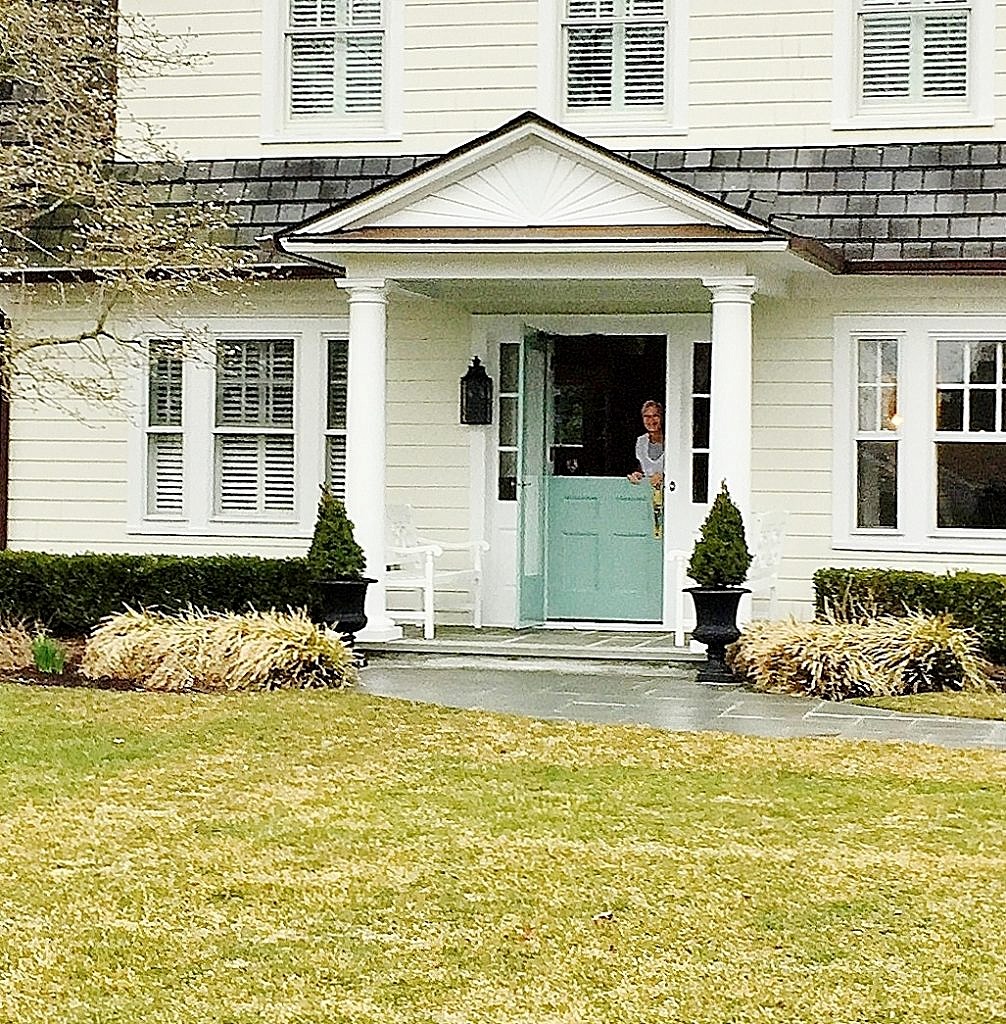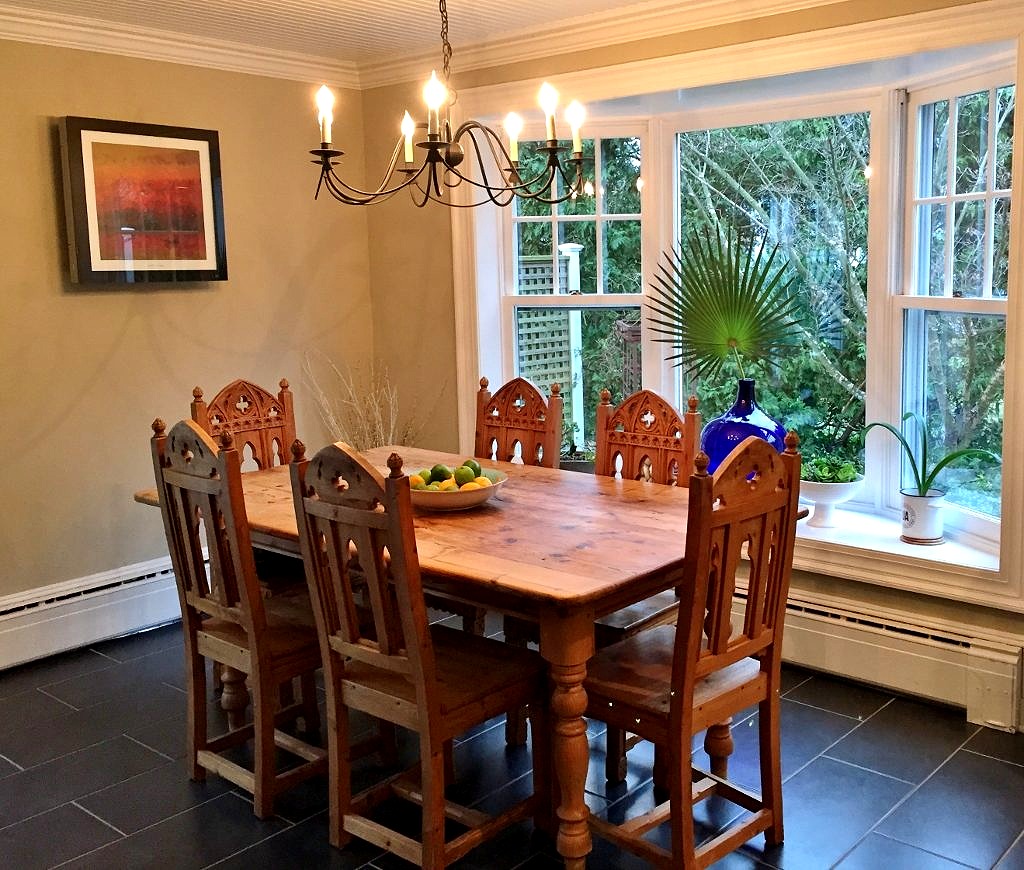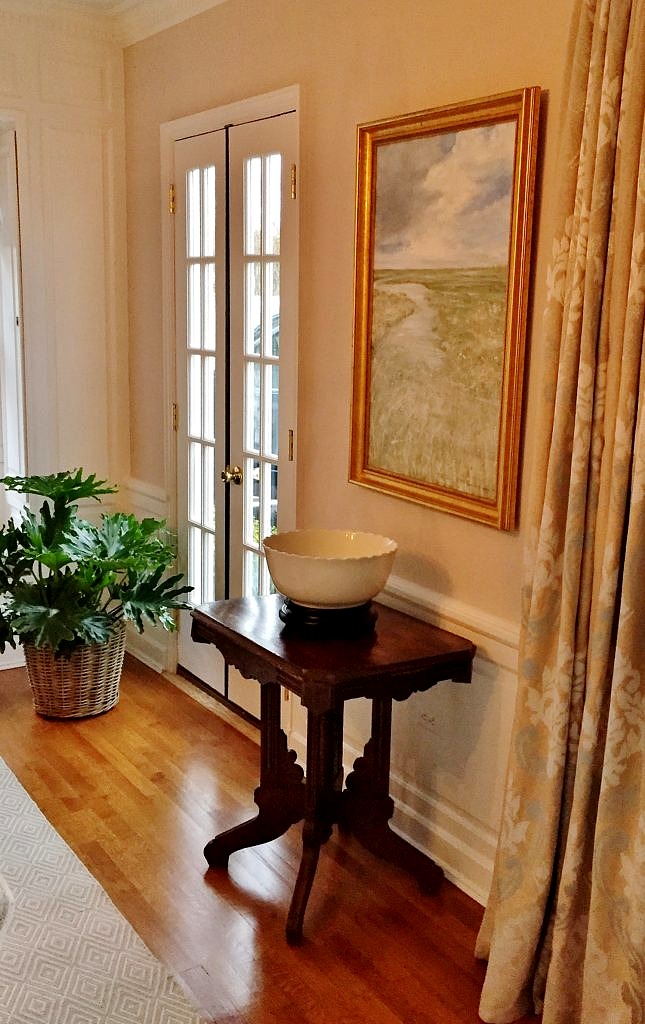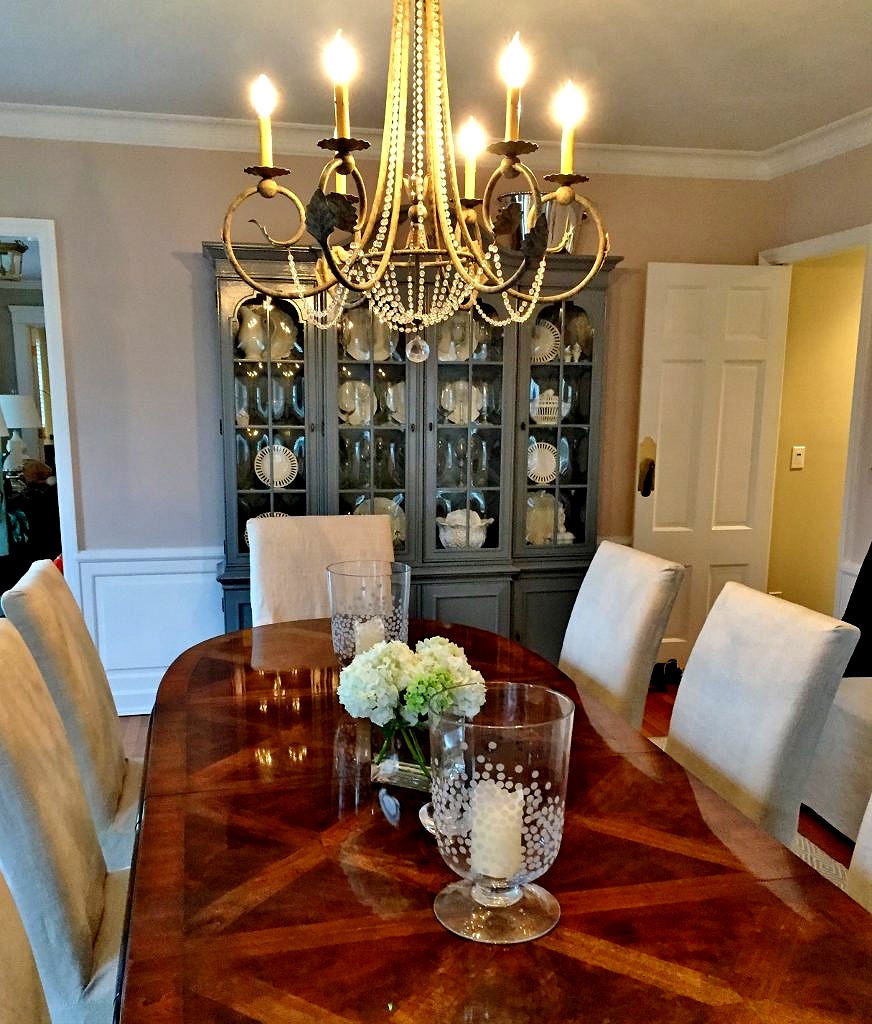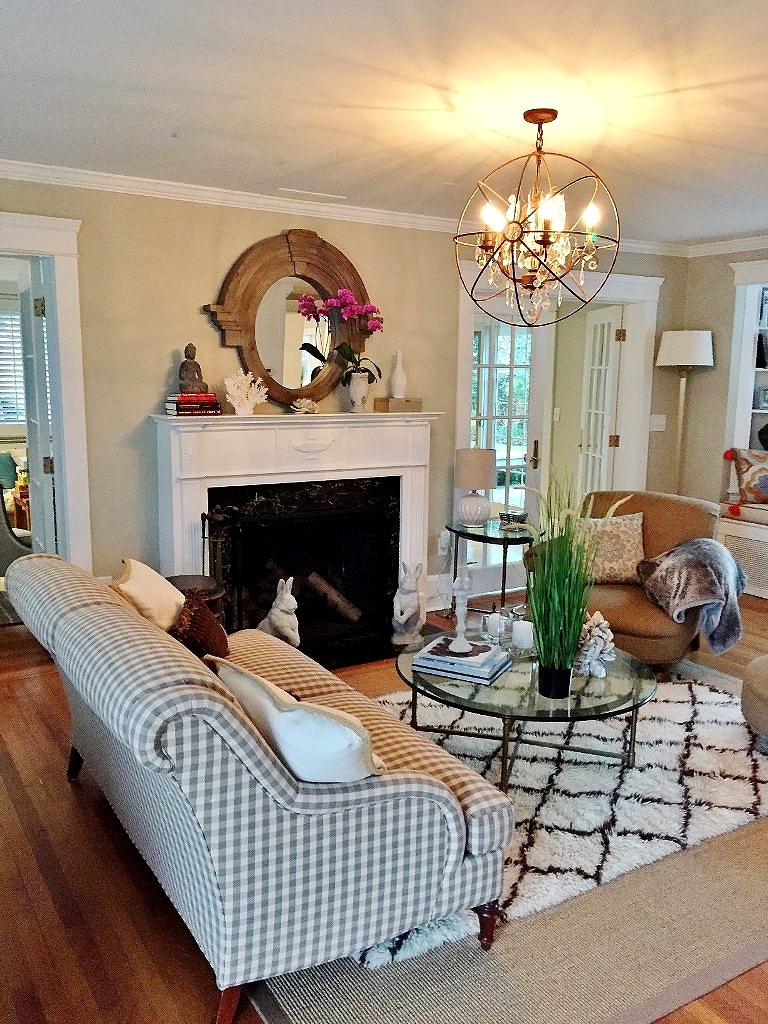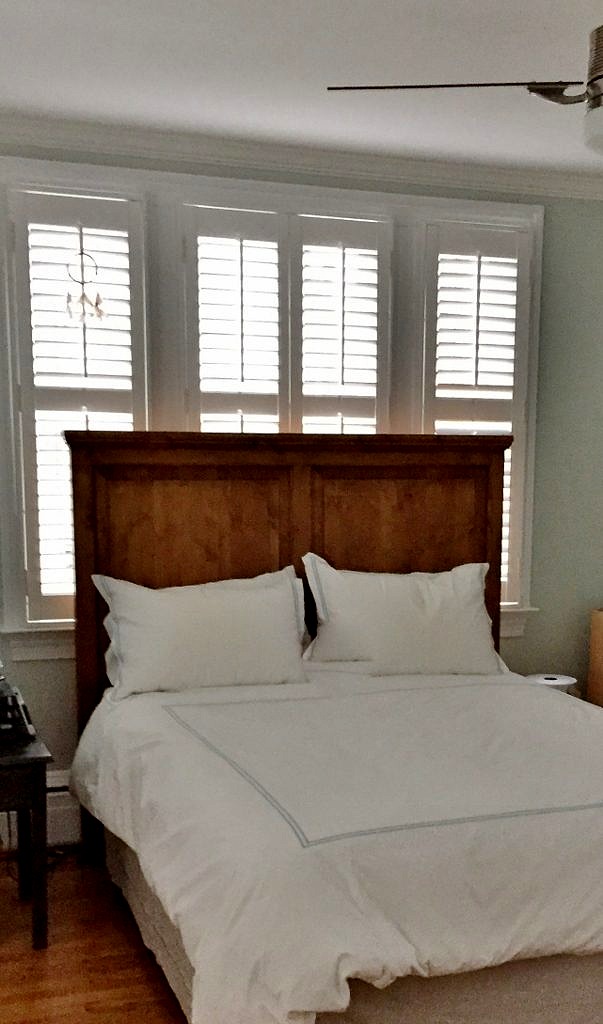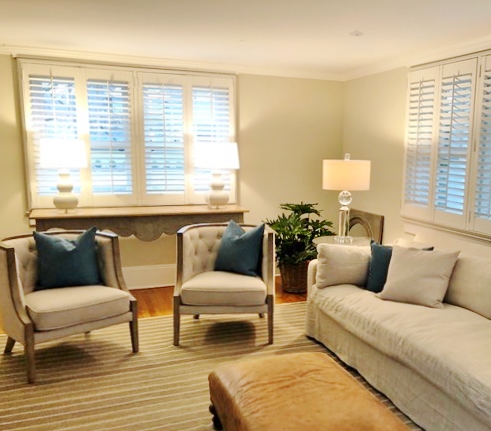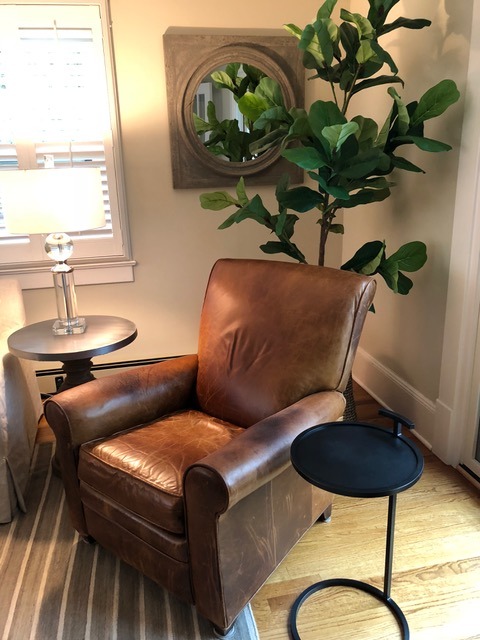Scottish Shortbread Recipe
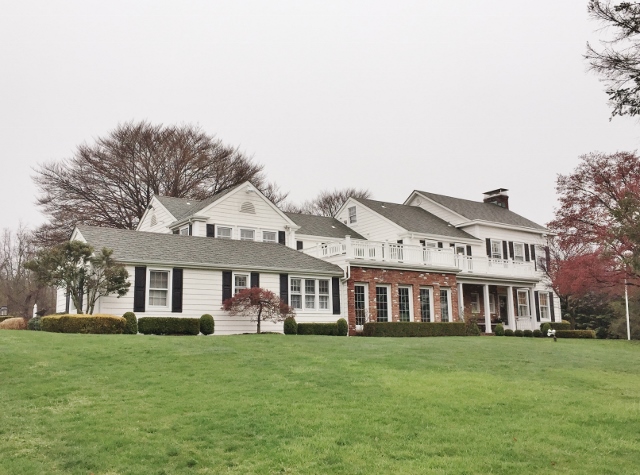 Built by German immigrants in 1840, Tip Top Farm in Colts Neck started out as a relatively modest asparagus farm, but by the mid-1900s it had become the country manse of the Chairman and chief stock holder of the National Starch Company. Now it is home to a thoroughly modern 21st century family.
Built by German immigrants in 1840, Tip Top Farm in Colts Neck started out as a relatively modest asparagus farm, but by the mid-1900s it had become the country manse of the Chairman and chief stock holder of the National Starch Company. Now it is home to a thoroughly modern 21st century family.
Along the way there were additions; to the house, and property–at one point the farm was nearly 50 acres. Unfortunately there were subtractions too–in the 1980s the property was subdivided and all the farm-related buildings were razed to make way for the houses that sprouted up next.
Fortunately the main house stayed intact, albeit with a bit of tweaking; each of the owners has left their mark. In lots of ways the story of Tip Top Farm is like a historical novel, the various occupants and their fortunes and misfortunes, mirrored the economic and historical events of their time–Downton Abbey here we come.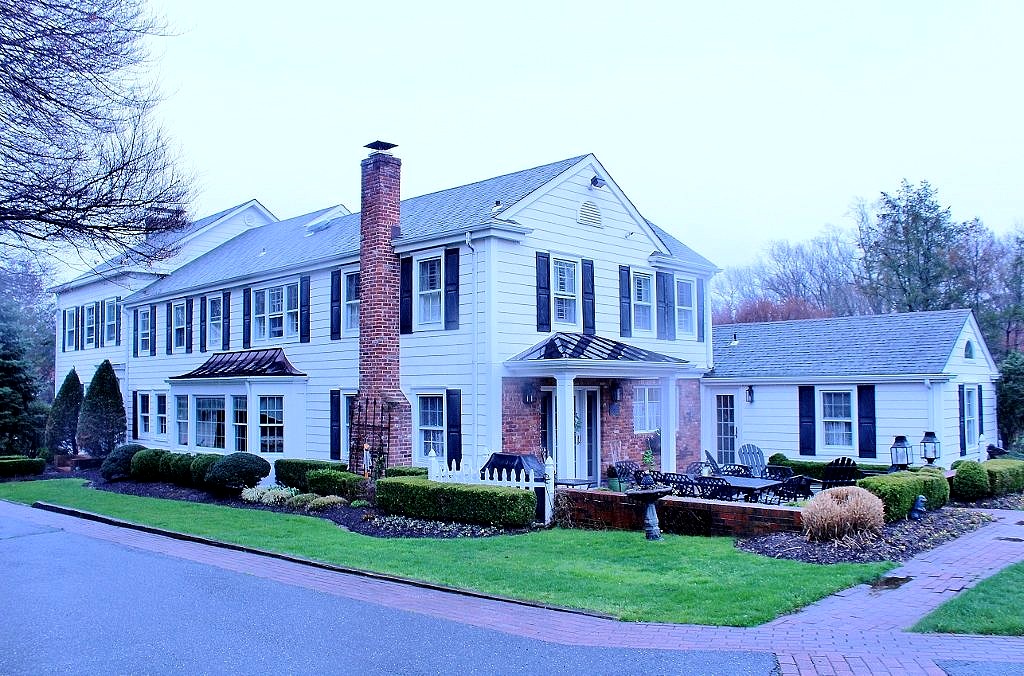
While walking through this house is like walking through a time machine; you would never mistake it for a museum. Even though they kept many of the original architectural details like thick crown molding, multiple fireplaces, hand-hewn beams and wide plank floors, over the the last 18 years the current owners painted, updated and transformed every single room– Happily stopping by British Cottage for furnishings and accessories each step of the way. What a relief to finally visit this fabulous home I’d heard so much about. And trust me it did not disappoint!
I’ll start with the formal living room which is textbook ready for a lesson on how to make a room that is often all buttoned up and off limits–attractive–and cozy. The overstuffed furniture, working fireplace and centrally located flatscreen tv keep this room in play. There is no doubt it looks refined but comfort rules.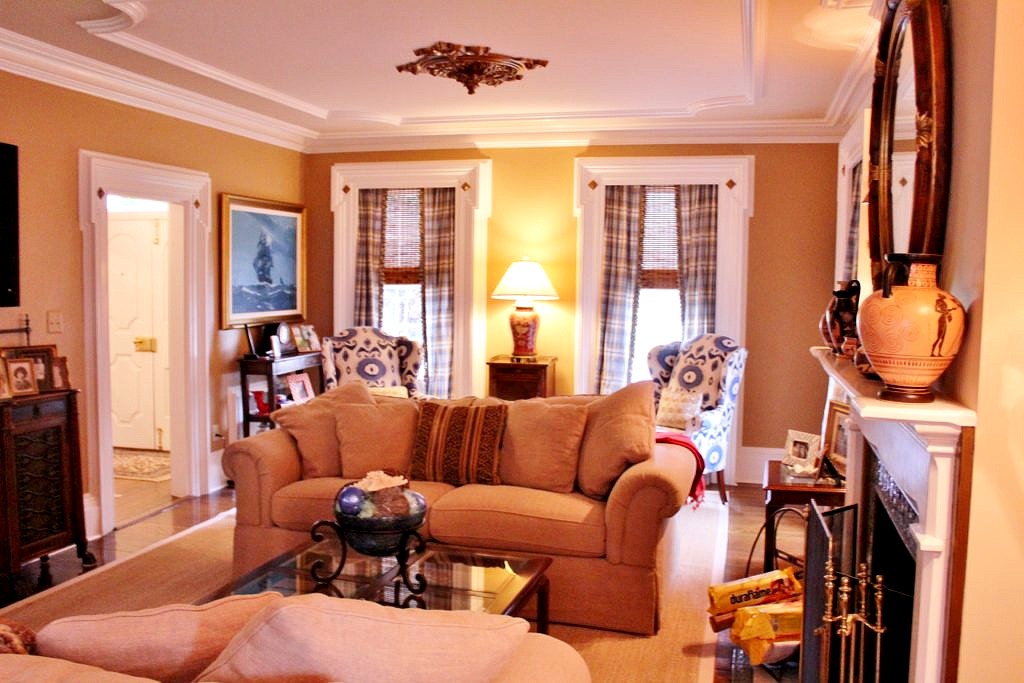
I liked how they anchored the television with an antique credenza, clustering the oft unlovely family photos below. These look great, and note how the vintage metal frames complement the tarnished brass feet and back railing of the sideboard.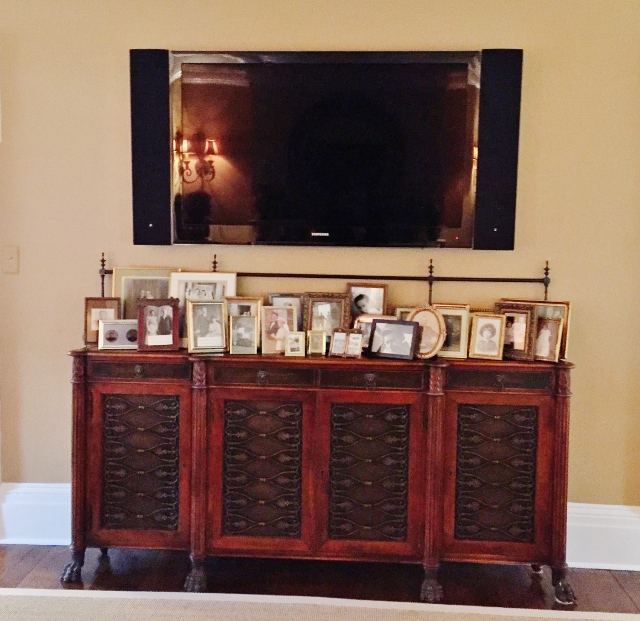 Next up is what was originally the library and now I would call it the family room. I was happy to be reunited with the oversized clock face we bought ten years ago for our Potting Shed from heaven in the second Stately Homes by the Sea Showhouse. Not many people would have thought to put it here, but you have to admit it does pack a punch. The pine bench to the left is nearly 10 feet long and neatly fills the space–as it did in our upstairs hallway until the homeowner spied it!
Next up is what was originally the library and now I would call it the family room. I was happy to be reunited with the oversized clock face we bought ten years ago for our Potting Shed from heaven in the second Stately Homes by the Sea Showhouse. Not many people would have thought to put it here, but you have to admit it does pack a punch. The pine bench to the left is nearly 10 feet long and neatly fills the space–as it did in our upstairs hallway until the homeowner spied it!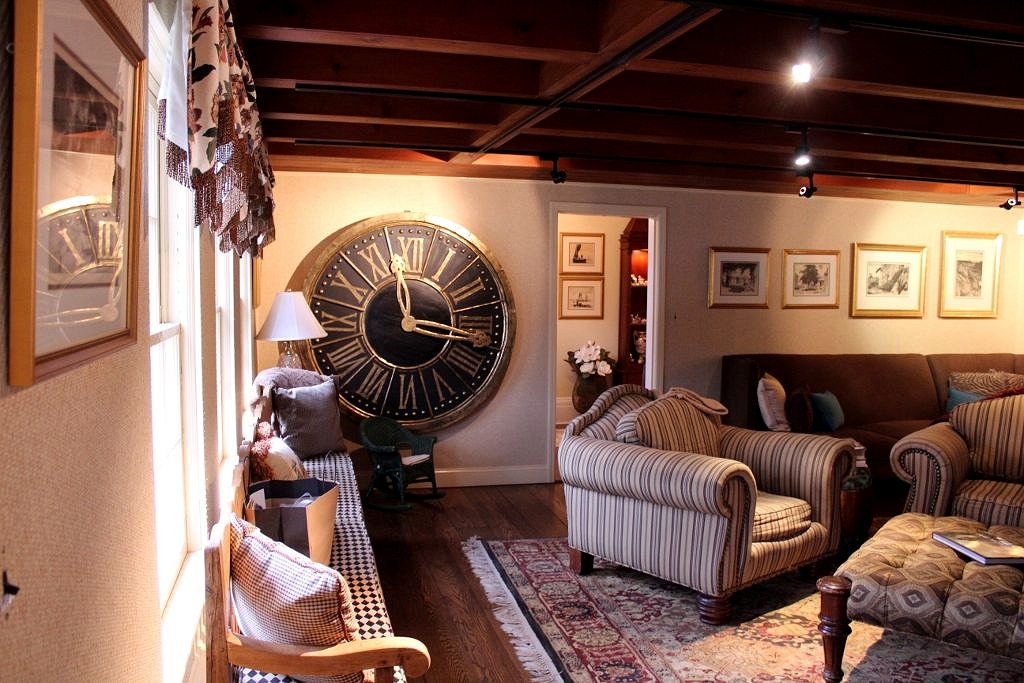 Next up is the dining room.
Next up is the dining room.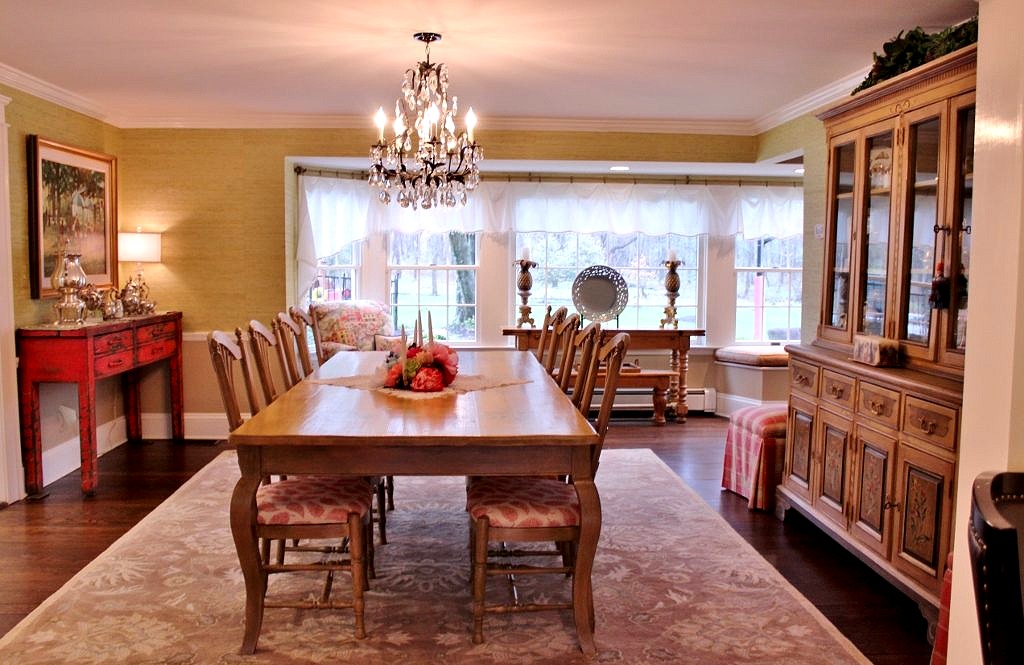
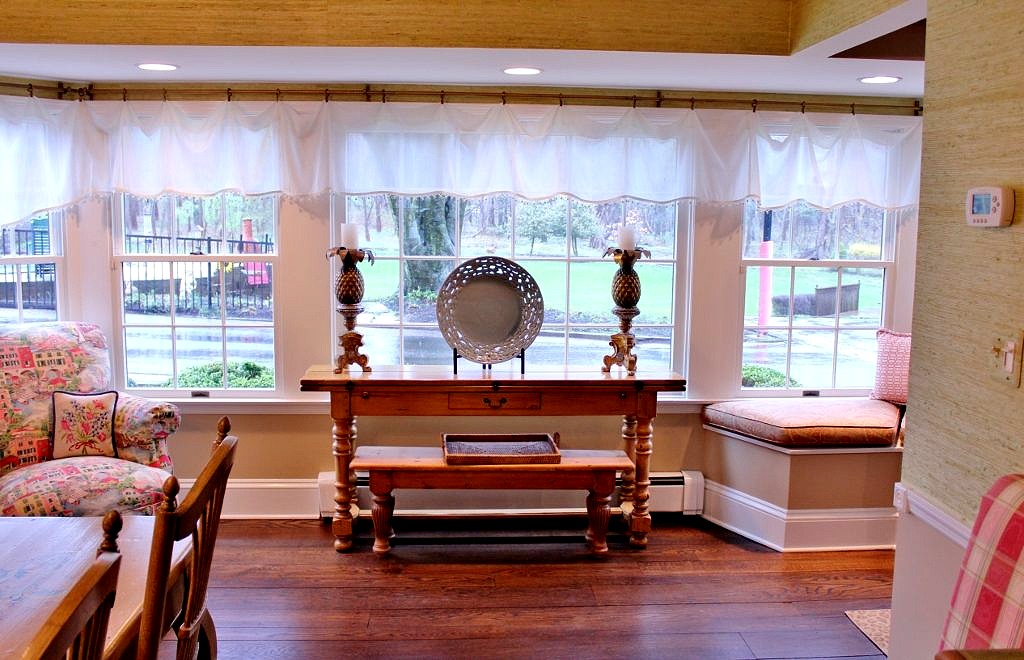 That is one of our fabulous flip top tables in the window. Closed it is the perfect console table but open it can sit eight. Everybody wants a more informal style dining table these days–but with a leaf–and mostly they don’t exist. So the two or three times a year you need more dining space this extra table cracks it. Note that tucked under the console table is a bench for–you guessed it–extra seating.
That is one of our fabulous flip top tables in the window. Closed it is the perfect console table but open it can sit eight. Everybody wants a more informal style dining table these days–but with a leaf–and mostly they don’t exist. So the two or three times a year you need more dining space this extra table cracks it. Note that tucked under the console table is a bench for–you guessed it–extra seating.
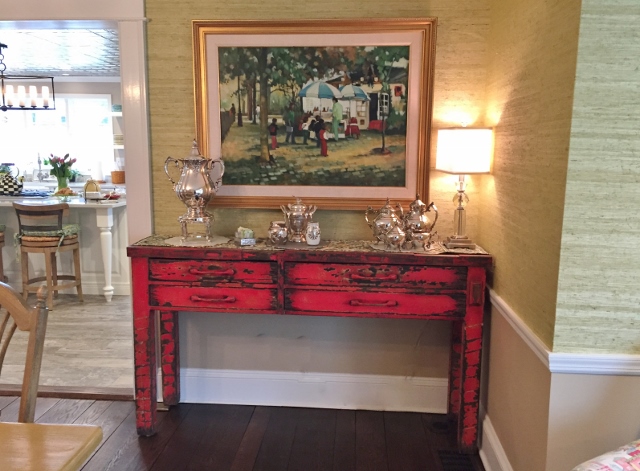 The red sideboard is another British Cottage find. Really distressed and on the industrial side so I admit I to being a bit perplexed when this went on the truck, but as you can see it is perfect for the spot.
The red sideboard is another British Cottage find. Really distressed and on the industrial side so I admit I to being a bit perplexed when this went on the truck, but as you can see it is perfect for the spot.
Adjacent to the dining room is the bar/lounge/sunroom. Once a screened in porch, it is now a four season room with a wall of windows that really brighten up this part of the house. We bought the antique pine sideboard in England years ago and it is massive. By now you may be sensing a common thread -these homeowners are absolutely fearless when it comes to decorating.
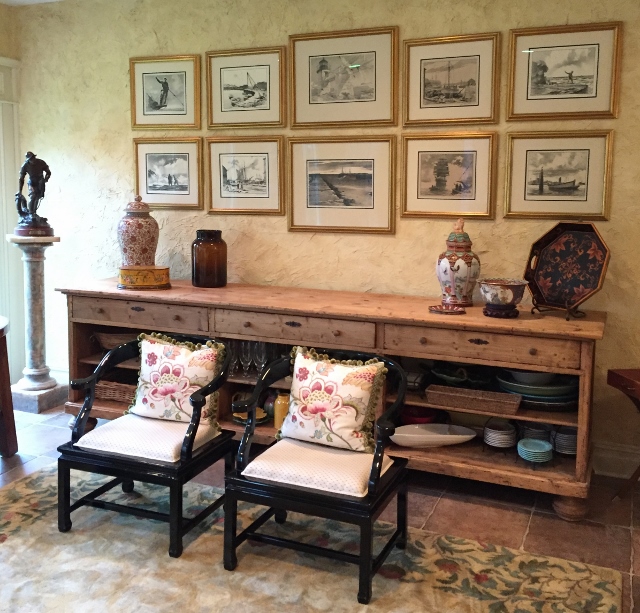
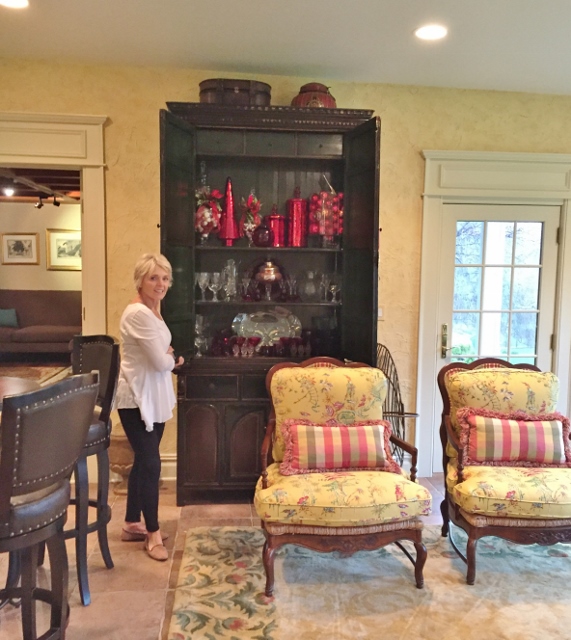 Another case in point is this most fabulous breakfront we found at Green Square Antiques in Copenhagen. It is an antique Scandinavian pine piece that the owners of Green Square had shipped to Poland to have lacquered. Then it was shipped back to Denmark and finally on to us in New Jersey; it is easily 8′ tall.
Another case in point is this most fabulous breakfront we found at Green Square Antiques in Copenhagen. It is an antique Scandinavian pine piece that the owners of Green Square had shipped to Poland to have lacquered. Then it was shipped back to Denmark and finally on to us in New Jersey; it is easily 8′ tall.
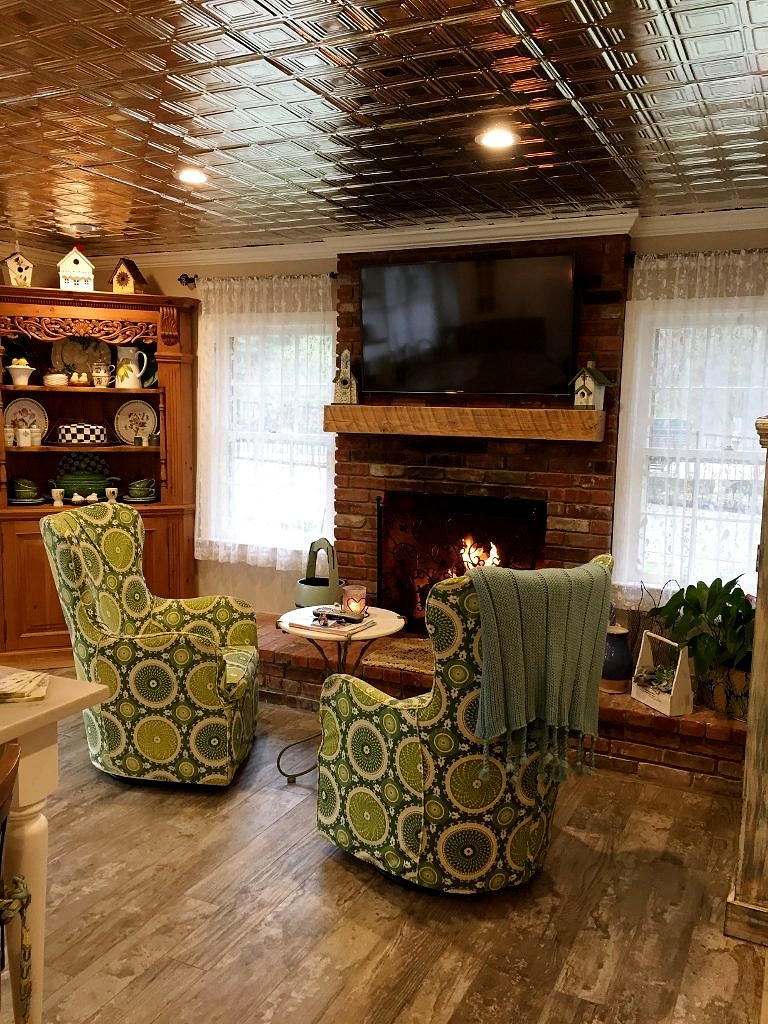 Finally I made it to the kitchen and the first piece of British Cottage furniture purchased for this home-the pine corner cupboard. Although the kitchen was totally renovated a few years ago, the cabinet stayed. I love everything about this room: the porcelain tile “wood” floor, the gorgeous tin ceiling, and the swivel chairs in a bold fabric.
Finally I made it to the kitchen and the first piece of British Cottage furniture purchased for this home-the pine corner cupboard. Although the kitchen was totally renovated a few years ago, the cabinet stayed. I love everything about this room: the porcelain tile “wood” floor, the gorgeous tin ceiling, and the swivel chairs in a bold fabric.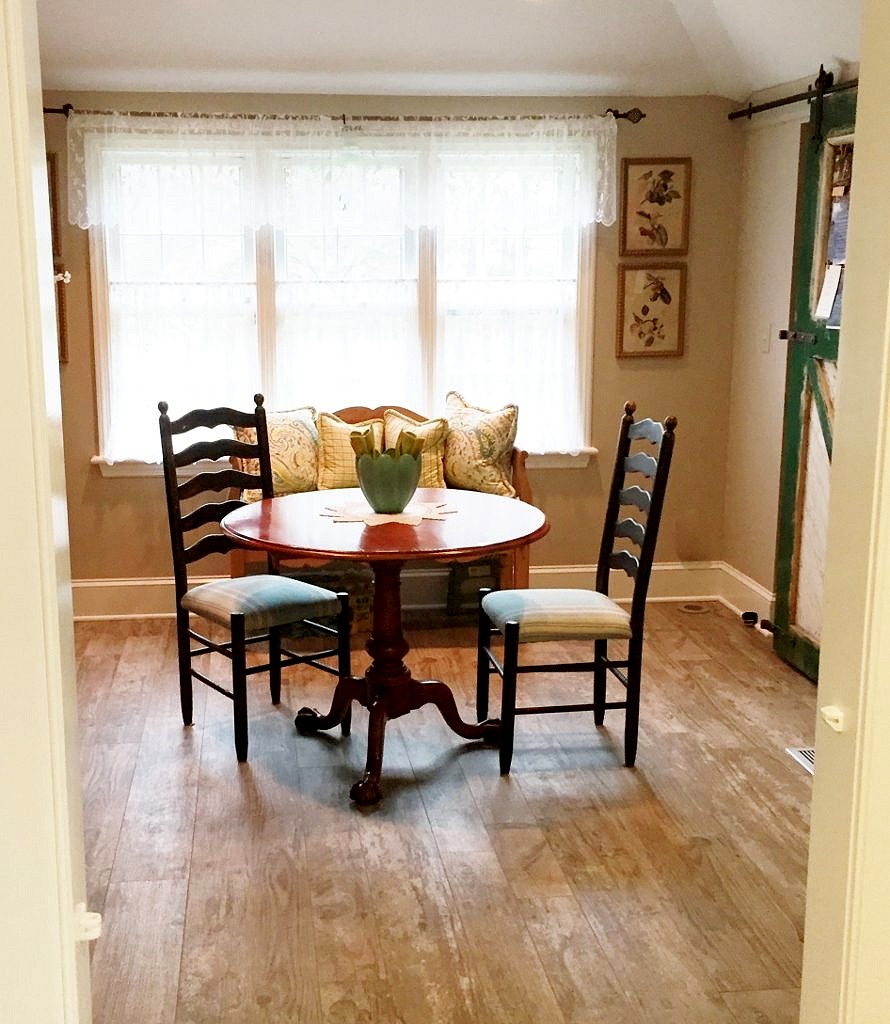 On the other side of the kitchen there is a breakfast room with a barn door concealing the pantry on one side. And custom cabinets on the other.
On the other side of the kitchen there is a breakfast room with a barn door concealing the pantry on one side. And custom cabinets on the other.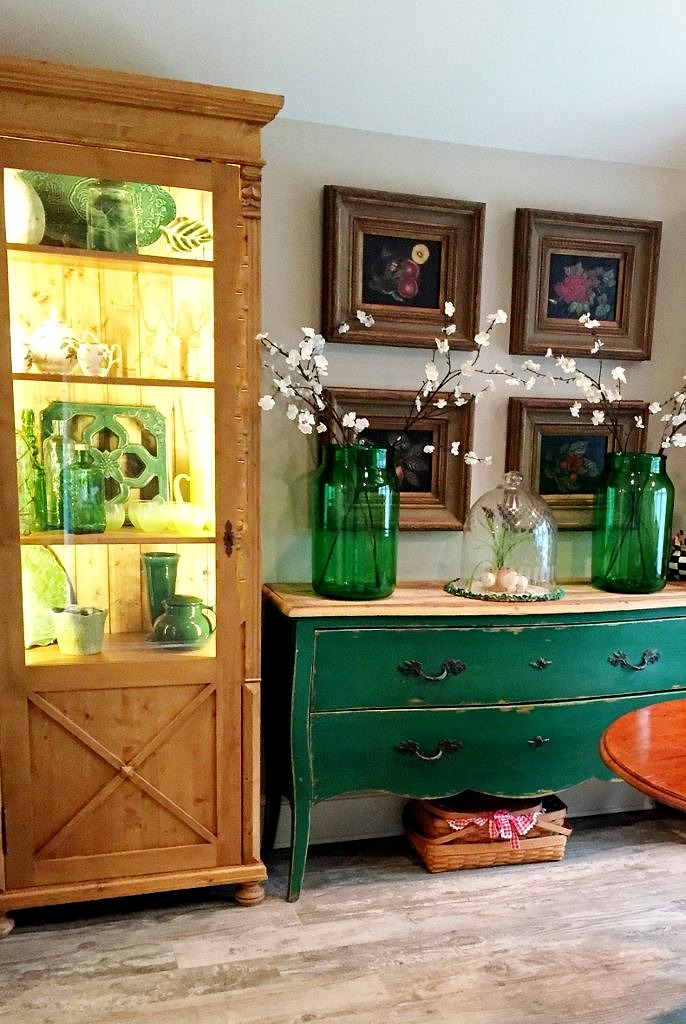 Instead of built ins for this breakfast nook/butlers pantry the owners had us make two cabinets to flank a painted pine chest with drawers. Note another decorating secret in action–you can be fearless with green because all greens go together. If you don’t believe me think of a forest.
Instead of built ins for this breakfast nook/butlers pantry the owners had us make two cabinets to flank a painted pine chest with drawers. Note another decorating secret in action–you can be fearless with green because all greens go together. If you don’t believe me think of a forest.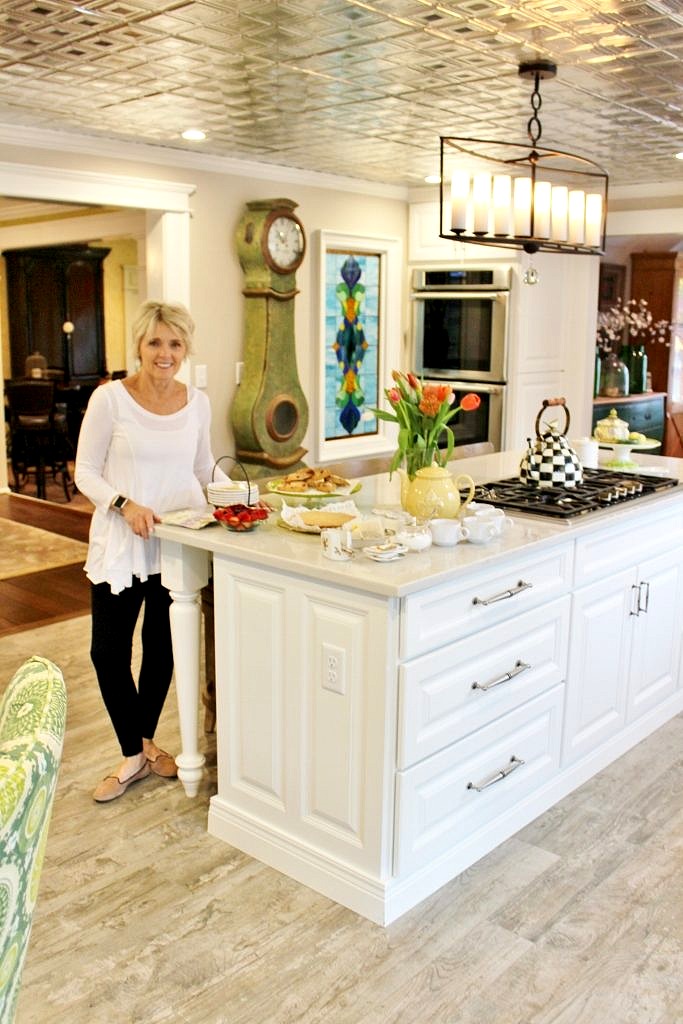
In the middle sits the nuts and bolts of the kitchen. But note how they still made room for some decorative elements. I’d completely forgotten about the fabulous antique Mora clock in original paint from Sweden…and couldn’t believe I’d sold it. Darn. It is stunning.
But so was the rest of this kitchen. The stained glass window where a door once hung, the gorgeous marble countertop which is really Calcutta-Grey Quartz. (Information that makes reading to the bottom of this blog totally worth the effort. There are pages and pages written about whether to not to use marble in a kitchen…this is the answer.)
Recipe for Scottish Shortbread
While there was still so much to see and admire I couldn’t ignore the refreshments any longer. Who would looking at this mouth-watering display? Strawberries and scones and homemade Scottish Shortbread. Heaven. Definitely time for a cuppa as my English mother-in-law would say.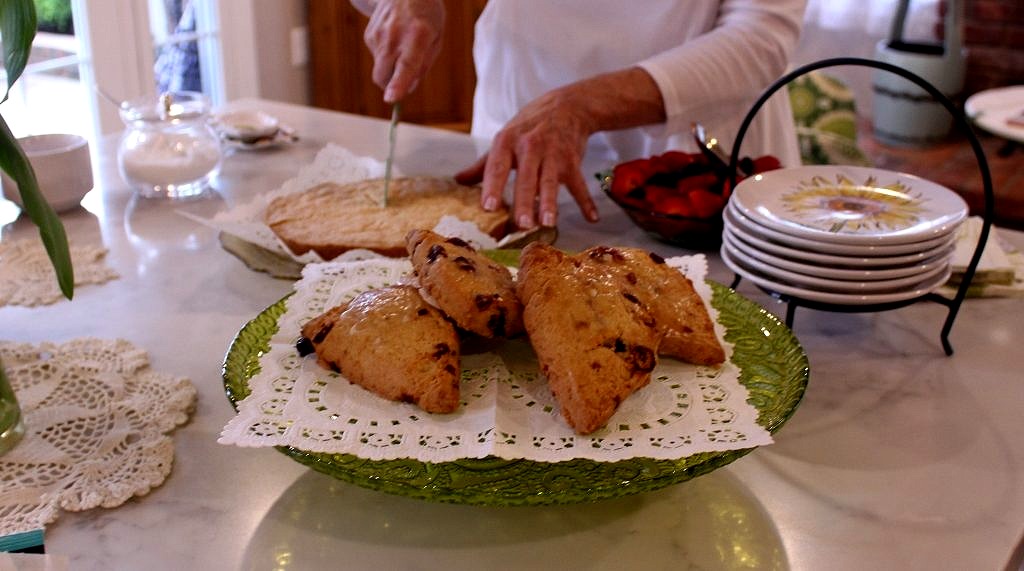
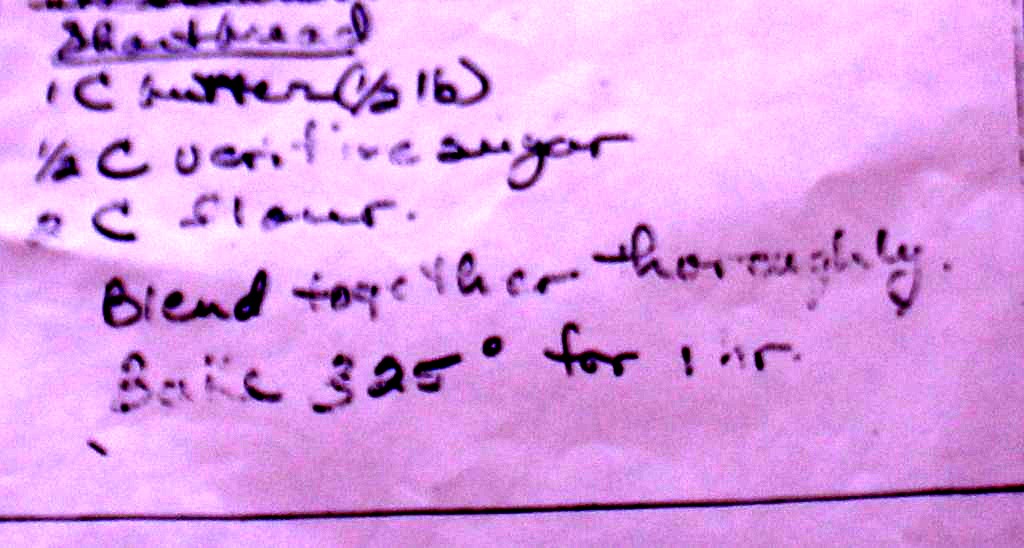 The original recipe from the owner’s grandmother, in her handwriting. Short and sweet and totally delicious.
The original recipe from the owner’s grandmother, in her handwriting. Short and sweet and totally delicious.
1 Cup Butter (1/2 Lb)
1/2 Cup Very Fine Sugar
2 Cups Flour
Blend together thoroughly.
Bake 325 degrees for 1 hour.
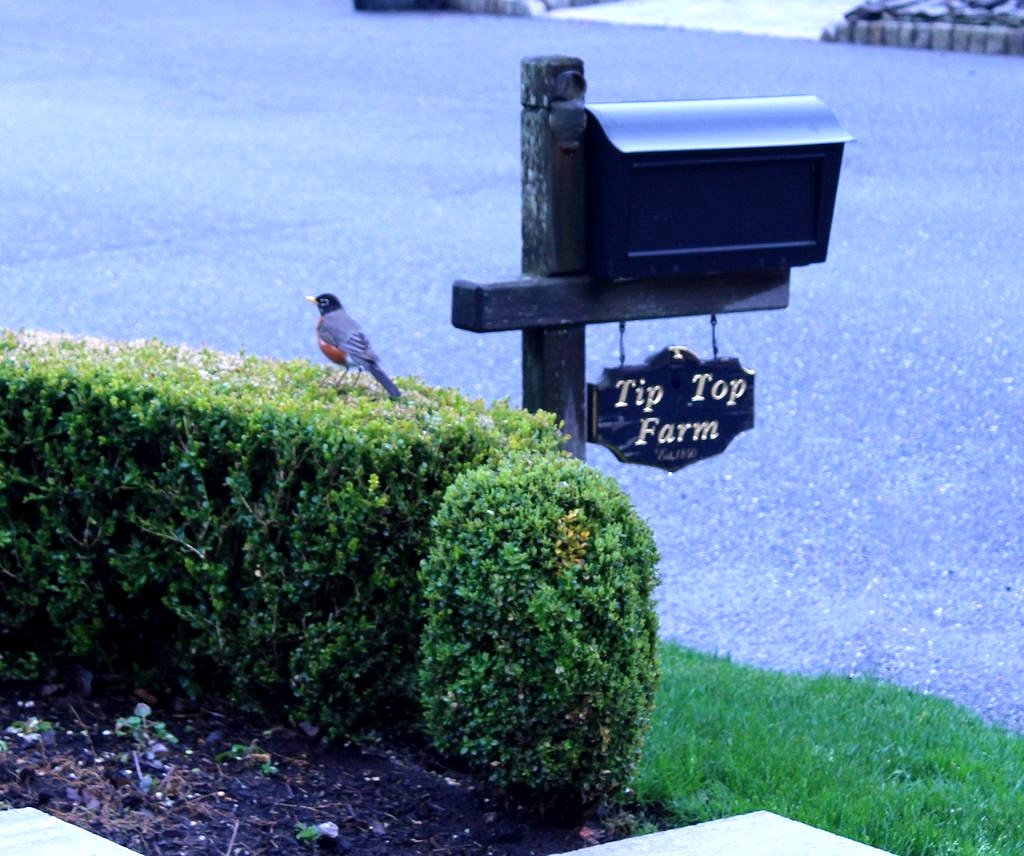
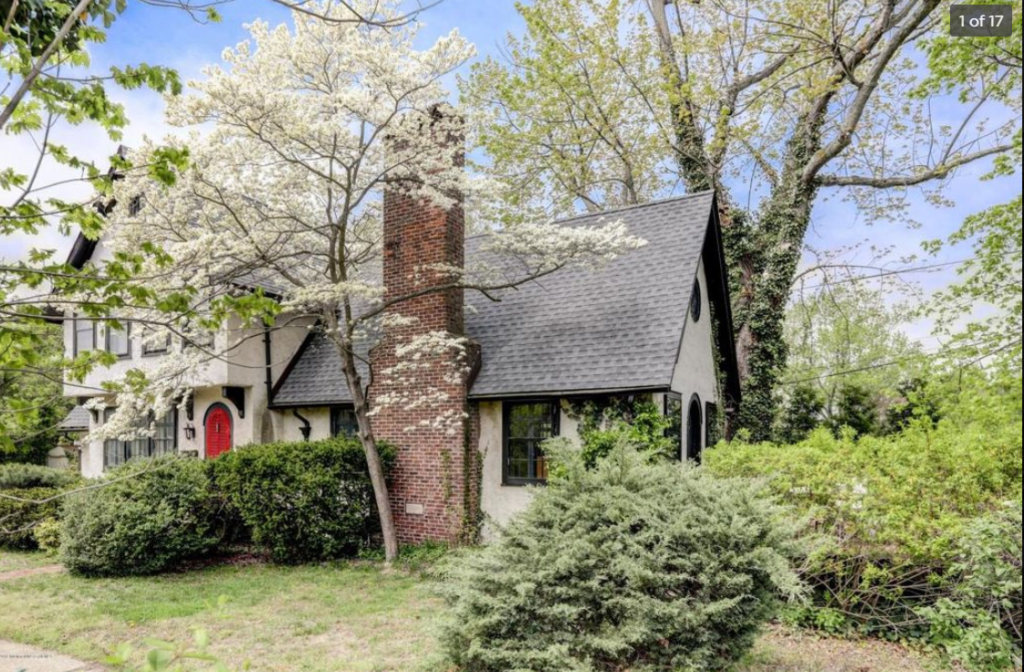
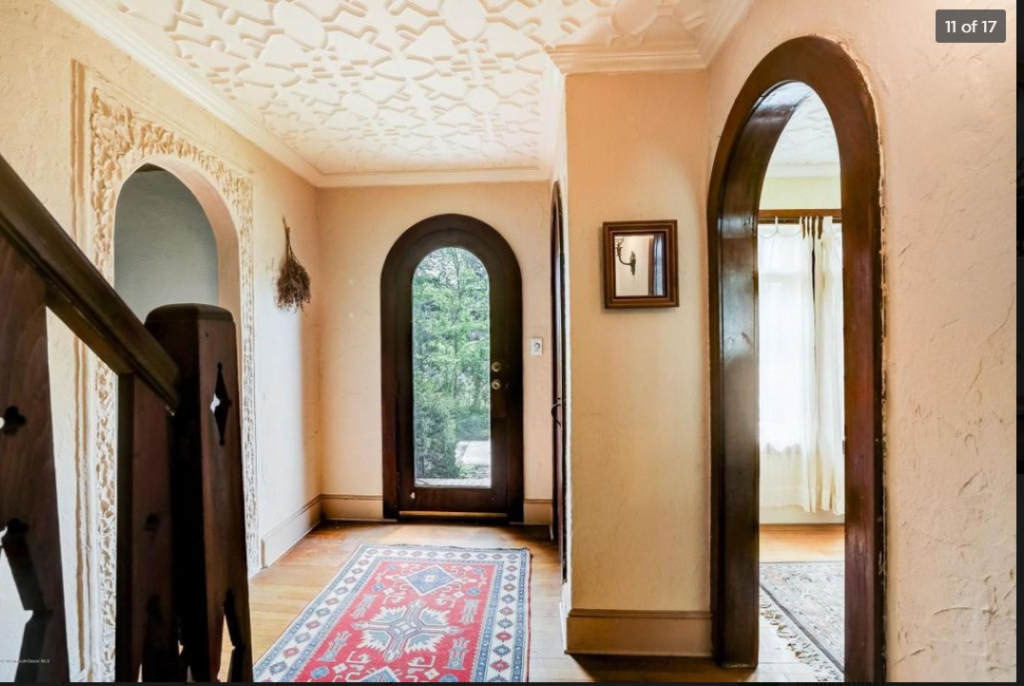
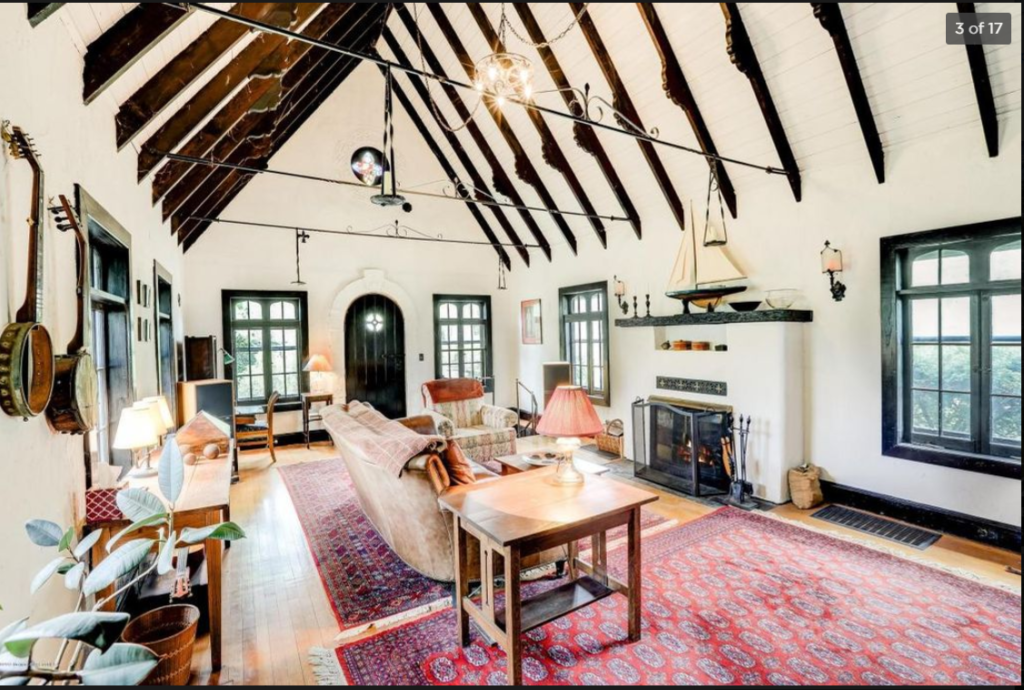 I was sold.
I was sold. 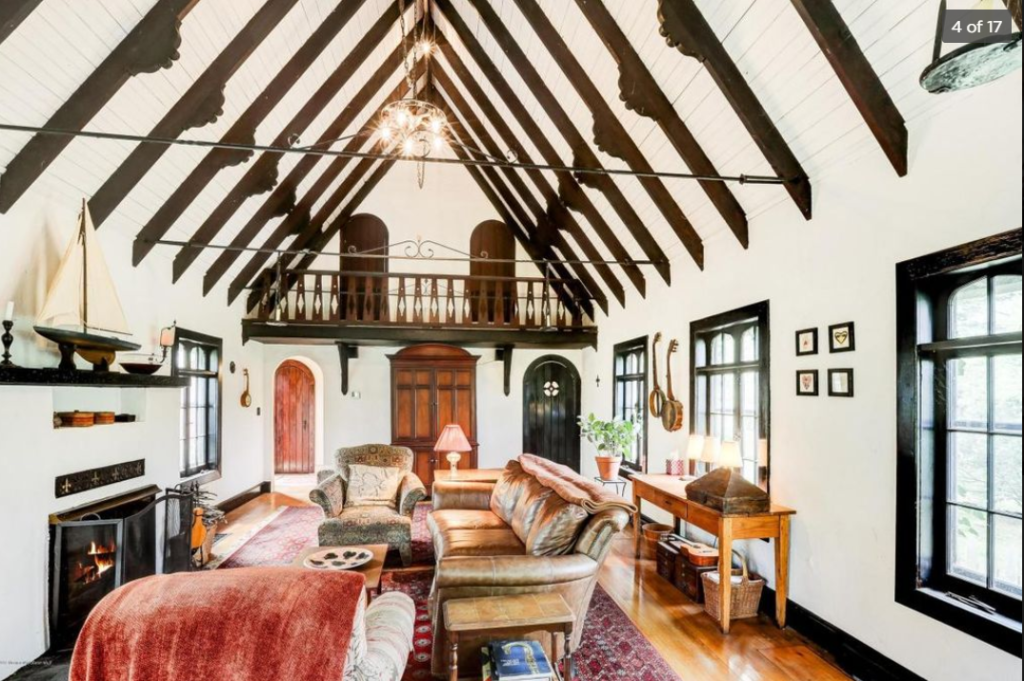 Forget that the rest of the house was a disaster: the basement indescribable, the filthy kitchen last updated in 1957, and the spartan one and a half baths not long after that. All I could think was how cool this room looks. To be honest Keith was, and is underwhelmed, but in the end, after a bit of hard bargaining and some unhappy inspection results we were able to purchase the property for substantially less than the asking price.
Forget that the rest of the house was a disaster: the basement indescribable, the filthy kitchen last updated in 1957, and the spartan one and a half baths not long after that. All I could think was how cool this room looks. To be honest Keith was, and is underwhelmed, but in the end, after a bit of hard bargaining and some unhappy inspection results we were able to purchase the property for substantially less than the asking price.

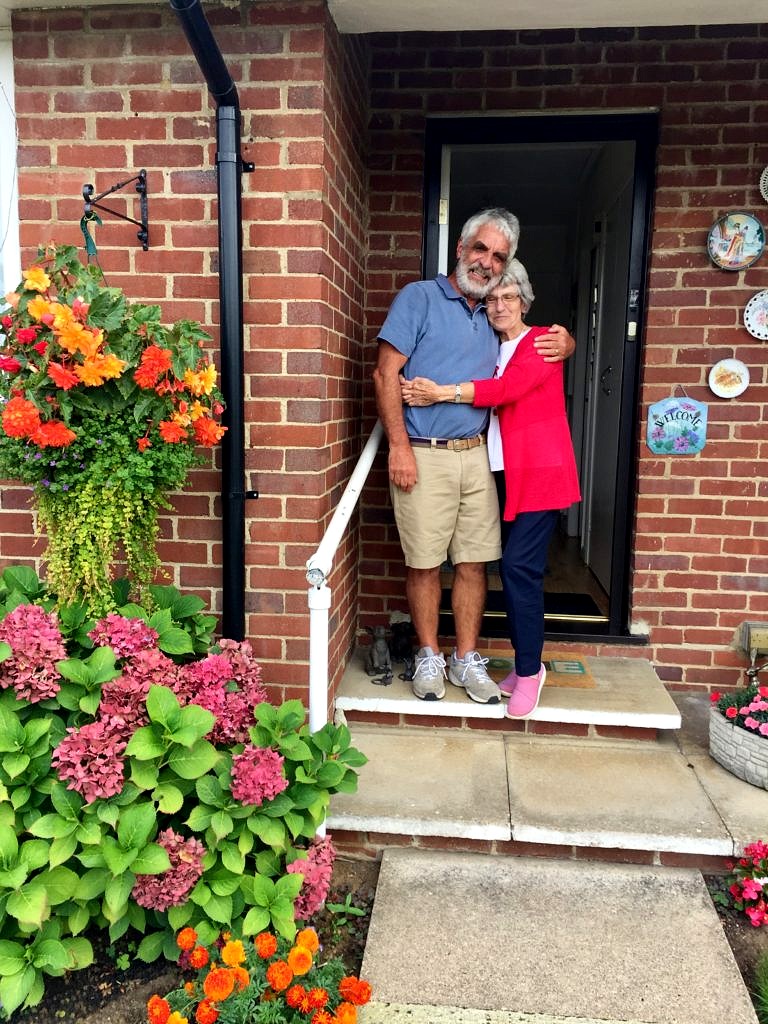 First stop was in Surrey where we met up with Keith’s Auntie Pat. No proper English home is without a garden and Pat always has one of the best. Love her hanging basket and bold use of color, so warm and welcoming.
First stop was in Surrey where we met up with Keith’s Auntie Pat. No proper English home is without a garden and Pat always has one of the best. Love her hanging basket and bold use of color, so warm and welcoming.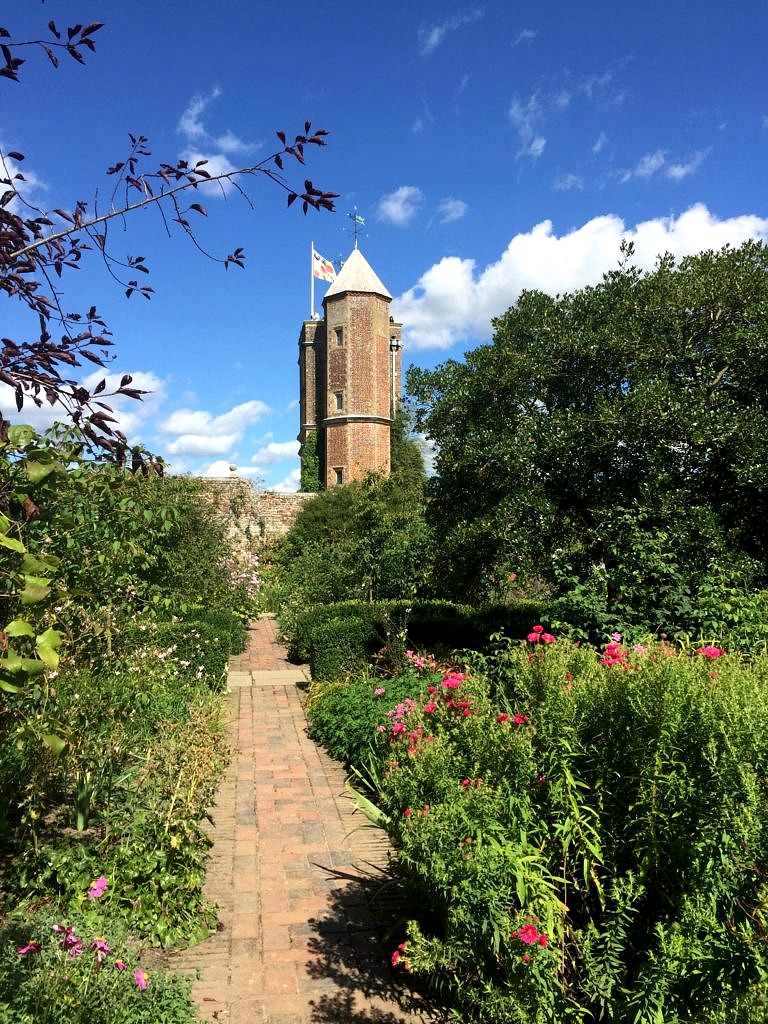 Next stop was arguably one of the most famous gardens in the United Kingdom: Sissinghurst, in nearby Kent. Originally owned by Vita Sackville-West and Harold Nicolson and now the National Trust, it is a must stop for garden lovers and English lit majors the world over. Vita was a Bloomsbury Group original, lover of Virginia Woolf, and gardener extraordinaire.
Next stop was arguably one of the most famous gardens in the United Kingdom: Sissinghurst, in nearby Kent. Originally owned by Vita Sackville-West and Harold Nicolson and now the National Trust, it is a must stop for garden lovers and English lit majors the world over. Vita was a Bloomsbury Group original, lover of Virginia Woolf, and gardener extraordinaire.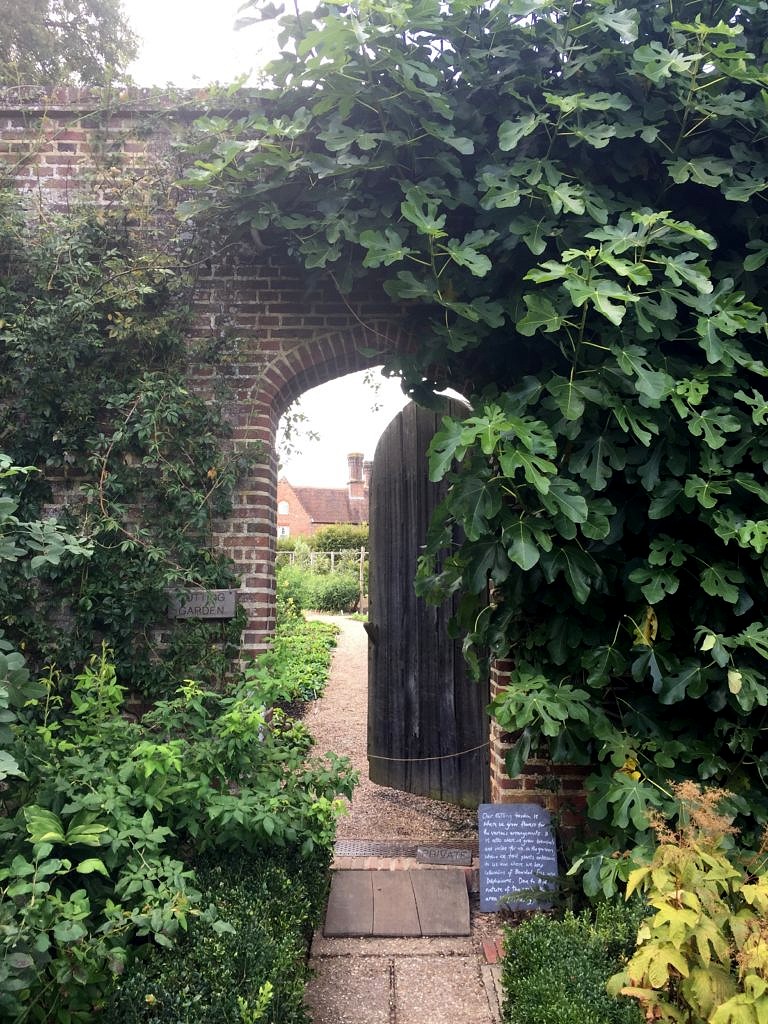
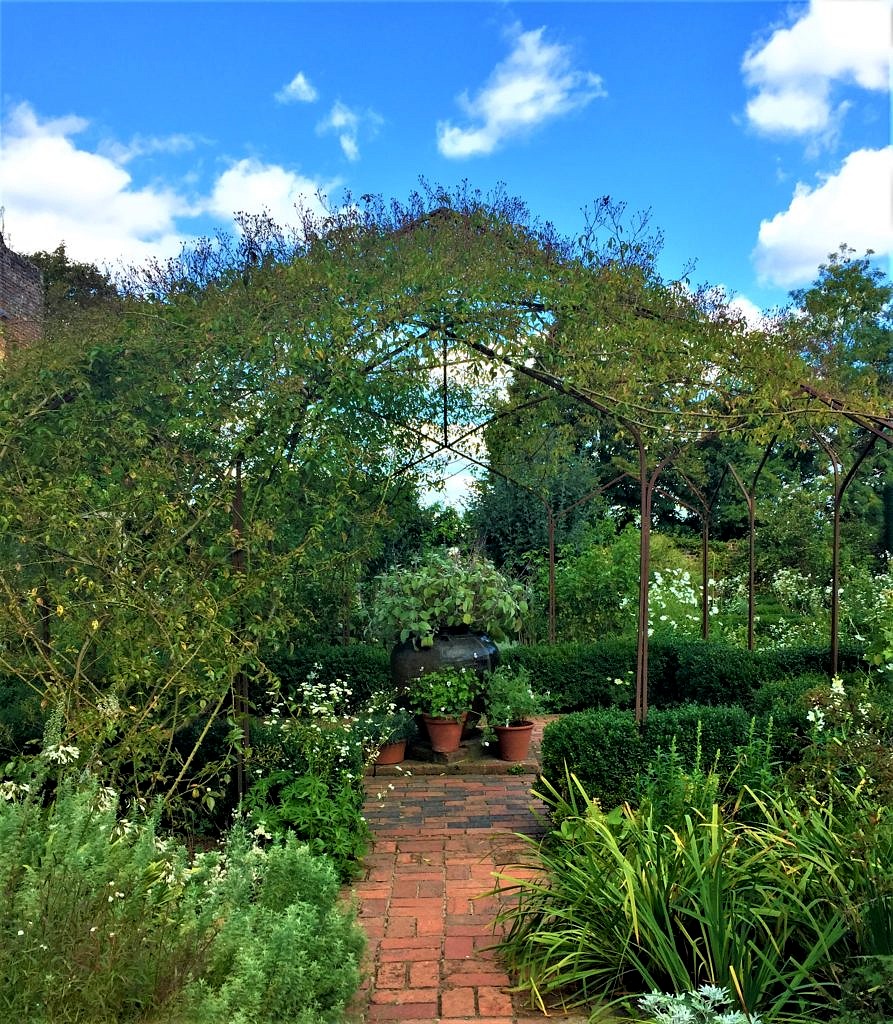 There was not a corner left untended–or unplanted and every turn brought another awesome vignette.
There was not a corner left untended–or unplanted and every turn brought another awesome vignette.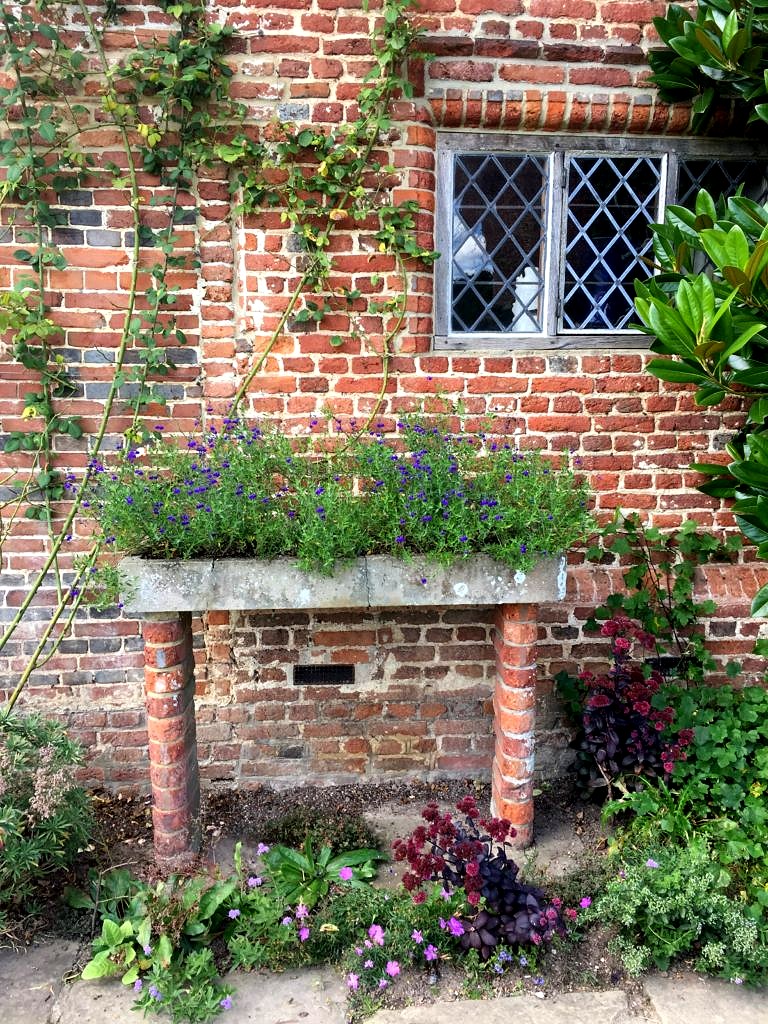
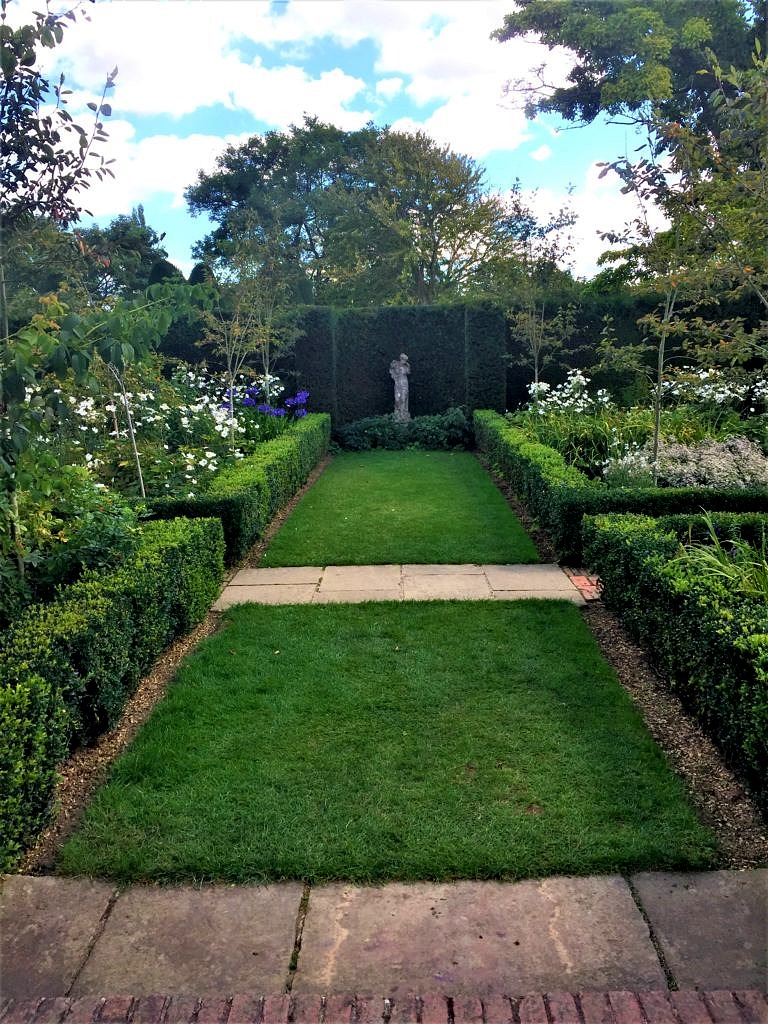 I probably took two hundred more photos; everywhere I looked there was a better shot. But, eventually cocktail hour approached and we were meeting a cousin at a fabulous
I probably took two hundred more photos; everywhere I looked there was a better shot. But, eventually cocktail hour approached and we were meeting a cousin at a fabulous 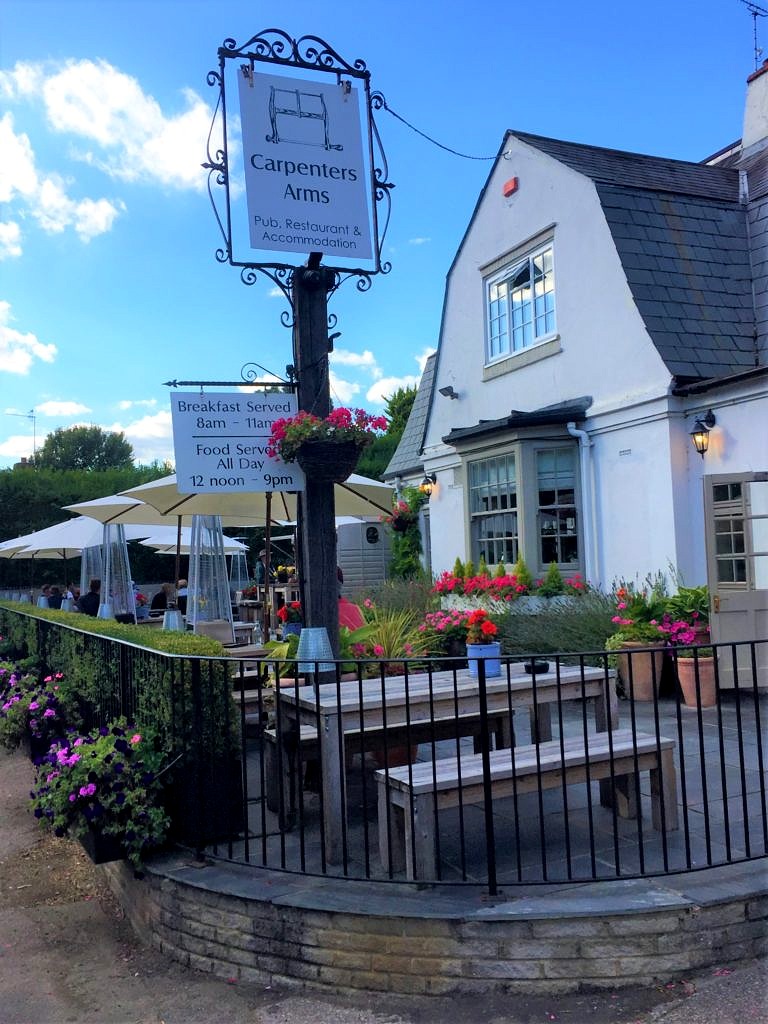 And time for a pint.
And time for a pint. Next we headed to Bognor Regis, a classic and classy seaside resort made famous by King George the V, and our home for the next few days while we enjoyed our niece Chantal’s wedding festivities.
Next we headed to Bognor Regis, a classic and classy seaside resort made famous by King George the V, and our home for the next few days while we enjoyed our niece Chantal’s wedding festivities.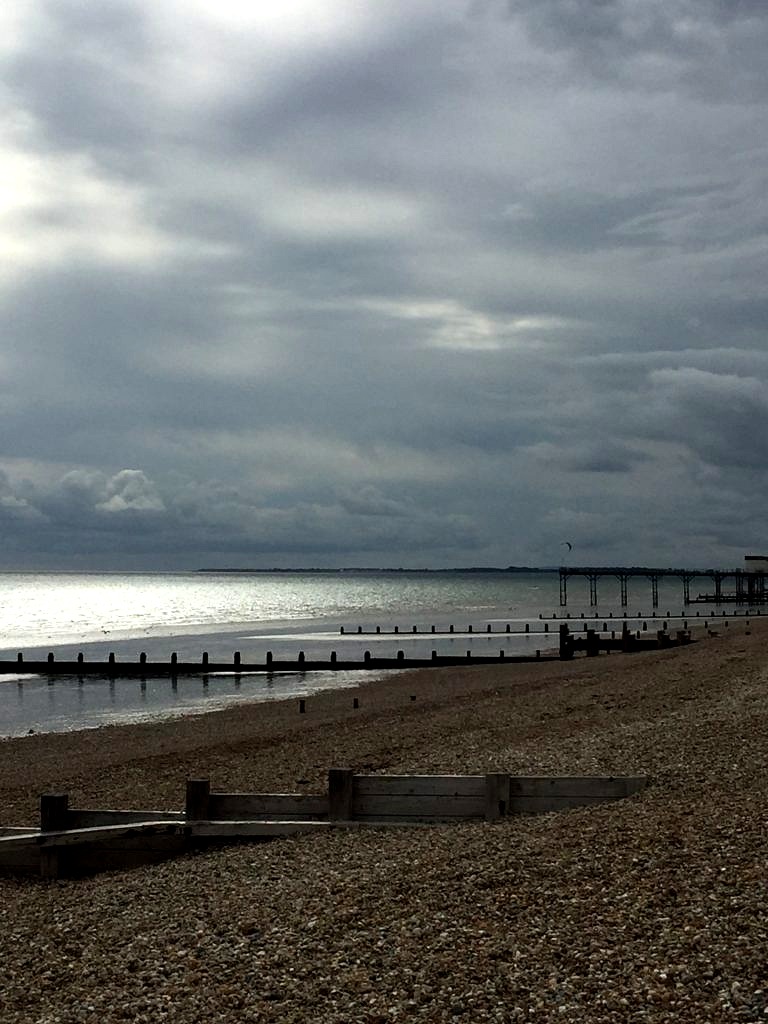
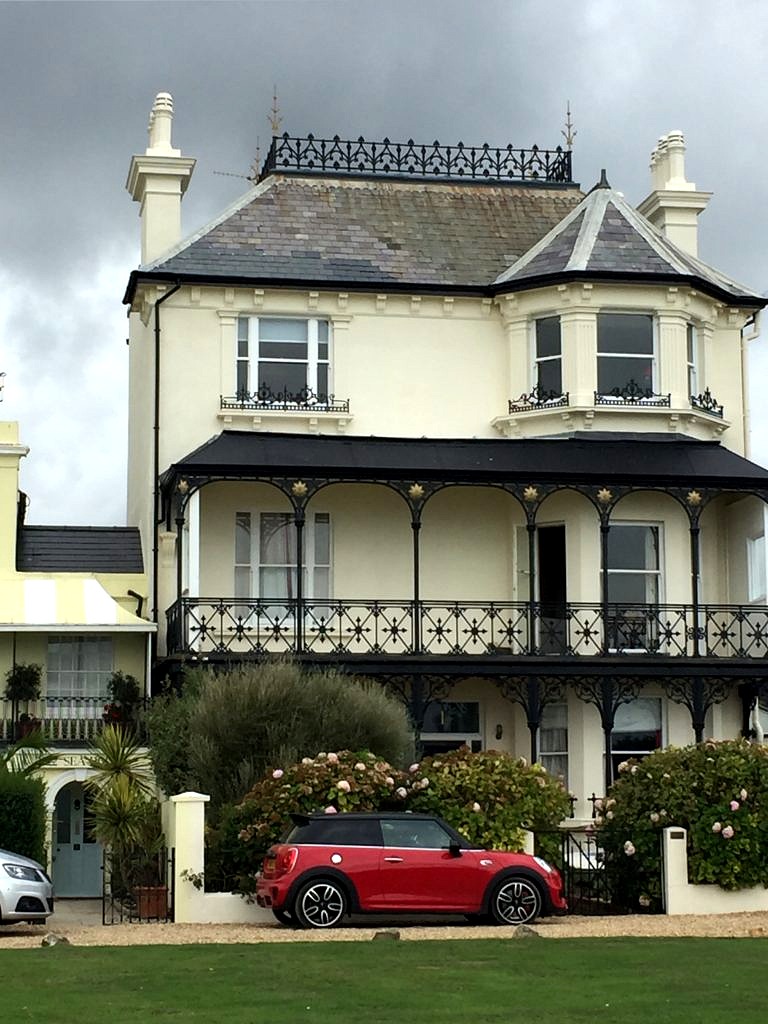 Between the seaside and the architecture Bognor Regis is a great place to stay so if you go to that part of the English coast give Brighton, the better known city just to the east, a miss–overcrowded and over-rated in my opinion–and stay in beautiful Bognor.
Between the seaside and the architecture Bognor Regis is a great place to stay so if you go to that part of the English coast give Brighton, the better known city just to the east, a miss–overcrowded and over-rated in my opinion–and stay in beautiful Bognor. 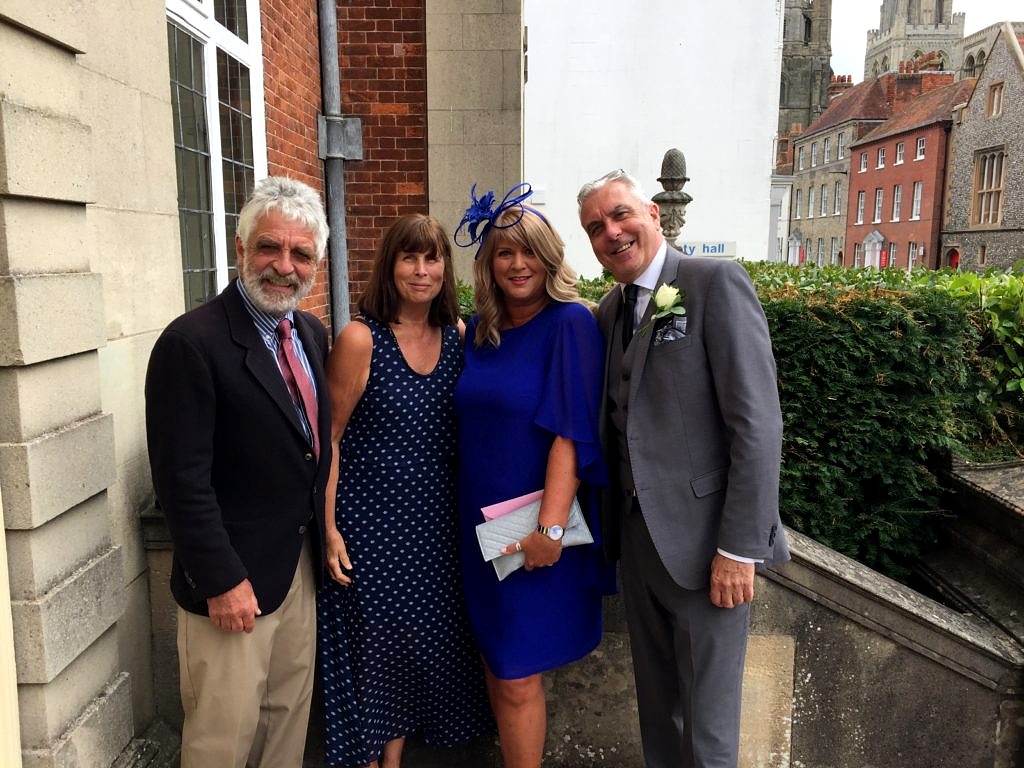 The wedding was a civil ceremony in the town hall in nearby Chichester. Here we are with Keith’s brother and his partner. (I decided against the fascinator; tempting as it was I felt it best to leave that look to the natives). The reception was a double decker bus ride away at the groom’s parents nursery and garden center just outside of town.
The wedding was a civil ceremony in the town hall in nearby Chichester. Here we are with Keith’s brother and his partner. (I decided against the fascinator; tempting as it was I felt it best to leave that look to the natives). The reception was a double decker bus ride away at the groom’s parents nursery and garden center just outside of town. Sadly all good things must pass, even weddings with six surfboard salutes; it was time for us to get to work. First stop,
Sadly all good things must pass, even weddings with six surfboard salutes; it was time for us to get to work. First stop, 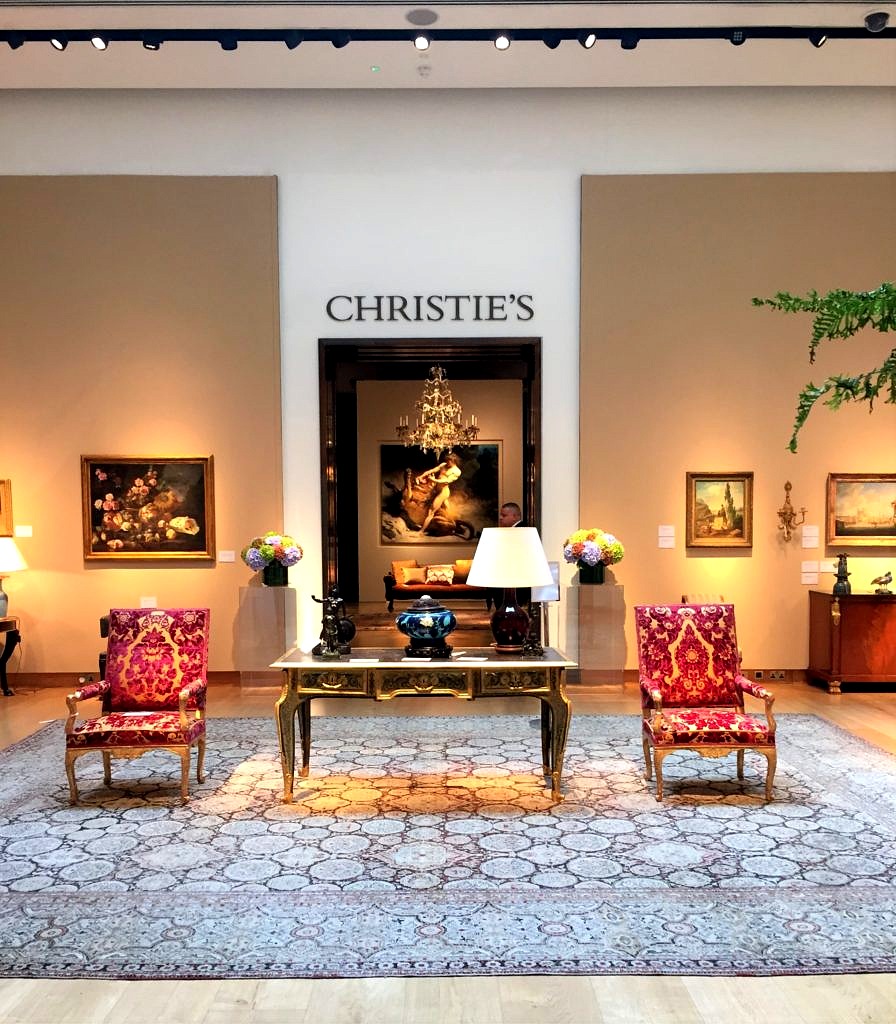 For probably around $10,000. (if the auction estimates were to be believed) you could furnish a living room–and dining room! Granted they were not period antiques, but who cares? Everything in the salesroom, whether antique or merely vintage, was well made, decorative and well worth the cost. We would have and probably should have and may well do in the future.
For probably around $10,000. (if the auction estimates were to be believed) you could furnish a living room–and dining room! Granted they were not period antiques, but who cares? Everything in the salesroom, whether antique or merely vintage, was well made, decorative and well worth the cost. We would have and probably should have and may well do in the future.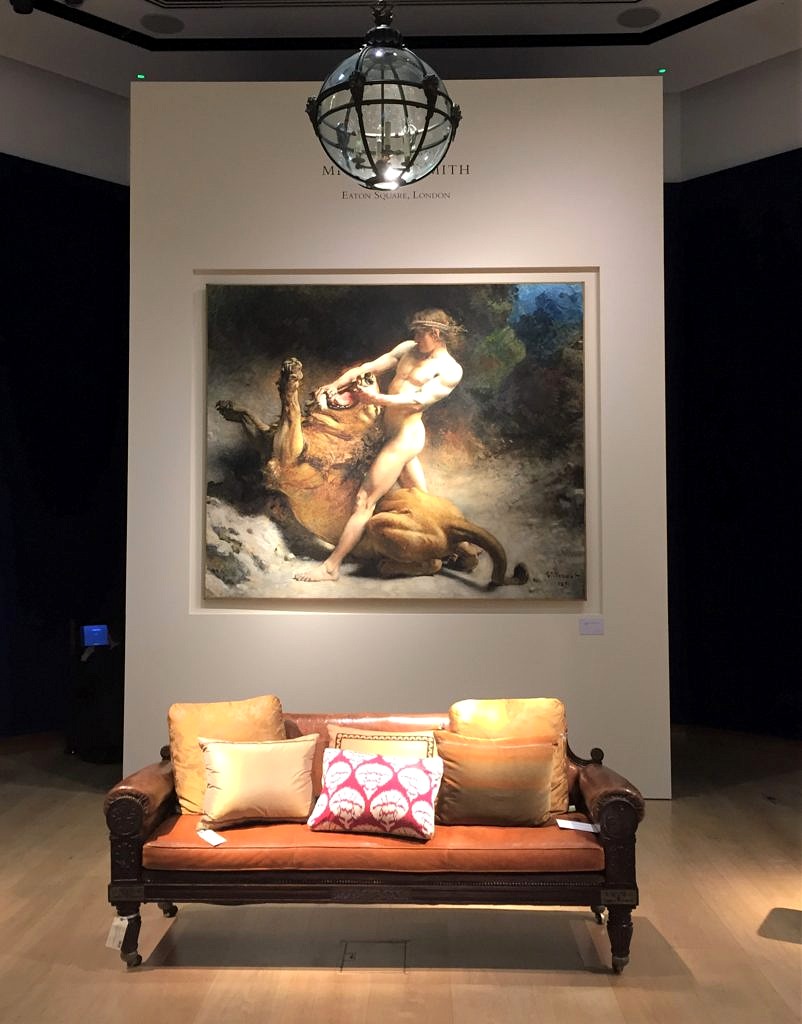 The other designer setting up the exhibition was
The other designer setting up the exhibition was 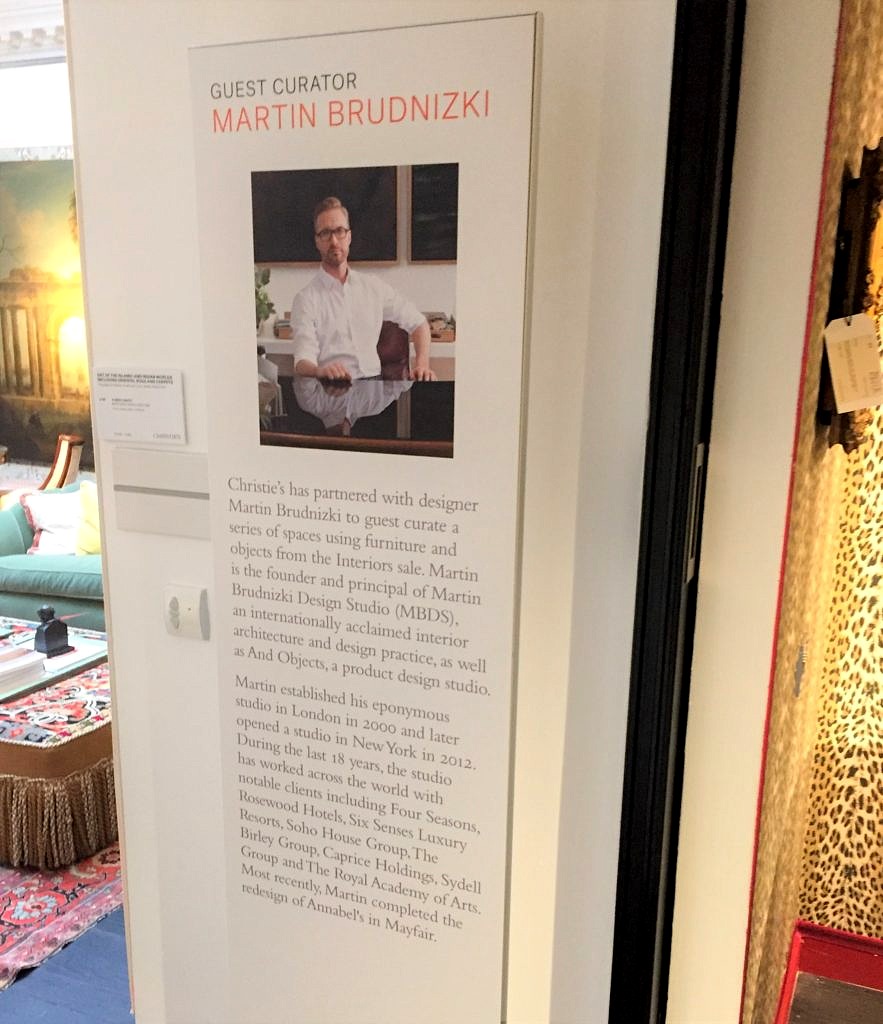 Check this out.
Check this out.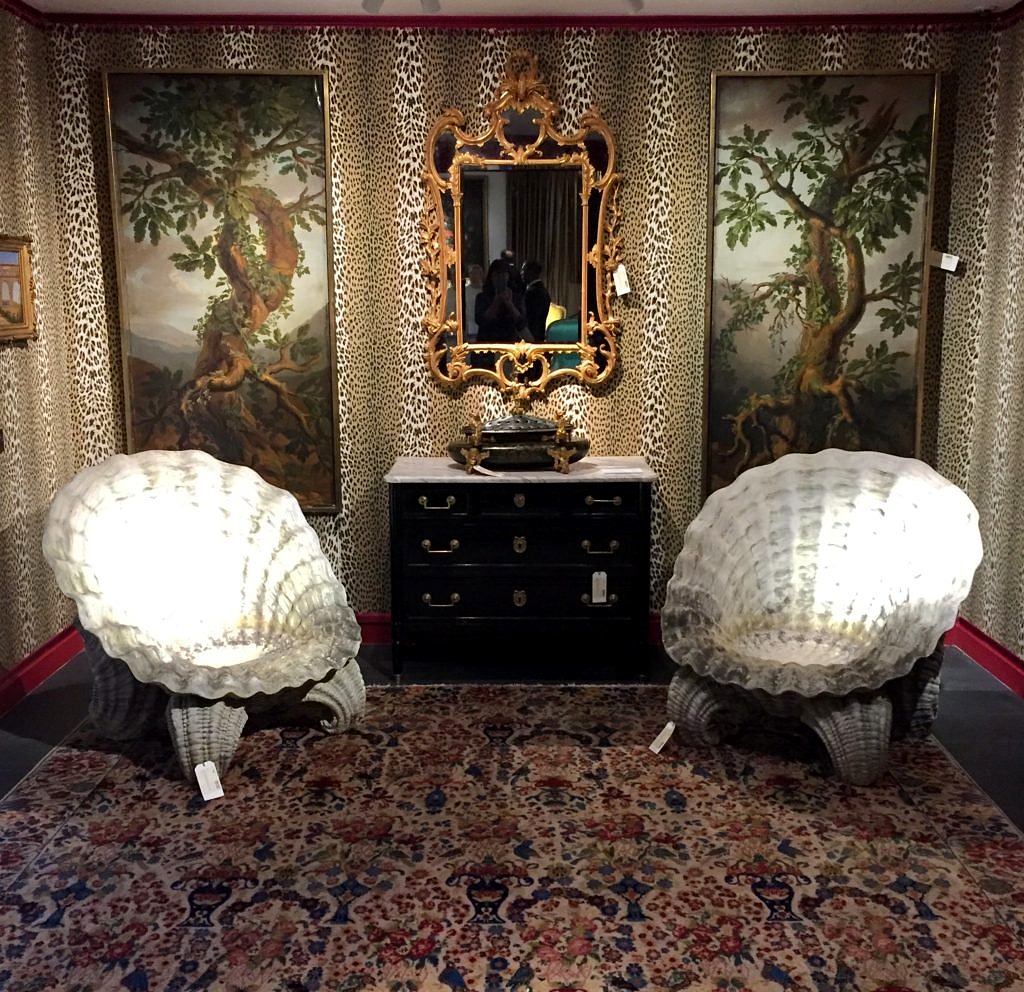 And this:
And this: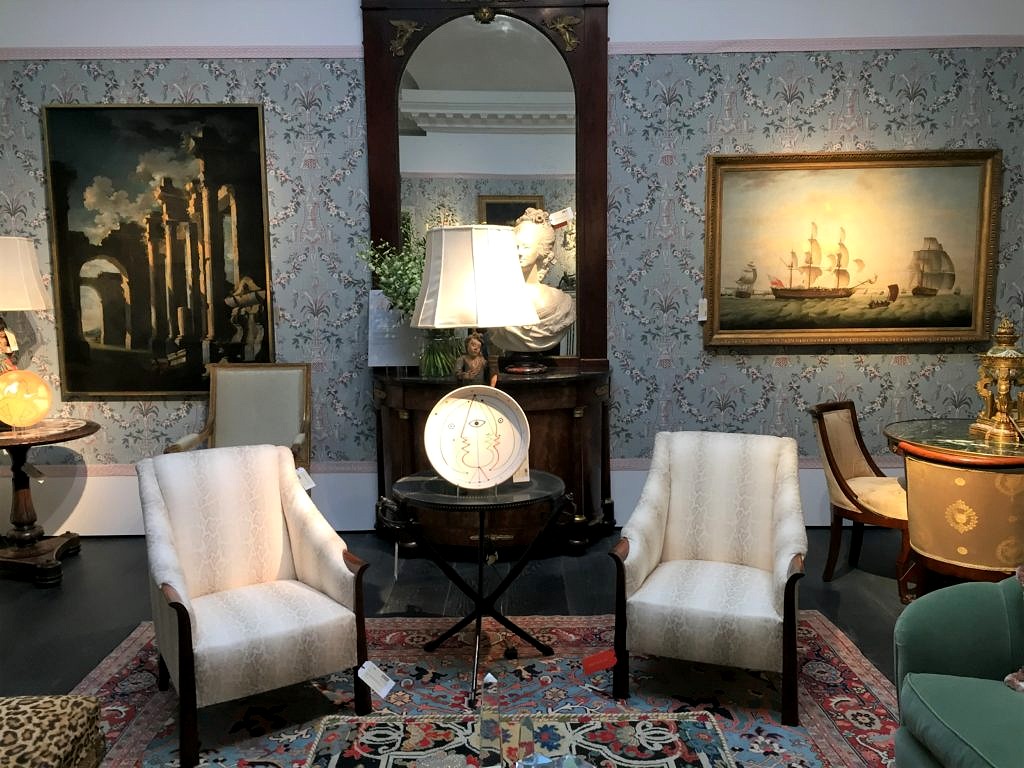 There was just a mad assortment of things old and new and what a great treat to see how these two design Ninjas put this with that and altogether came up with a whole room you just wanted to take home. Kudos to Christie’s for coming up with the idea to show objects in situ.
There was just a mad assortment of things old and new and what a great treat to see how these two design Ninjas put this with that and altogether came up with a whole room you just wanted to take home. Kudos to Christie’s for coming up with the idea to show objects in situ.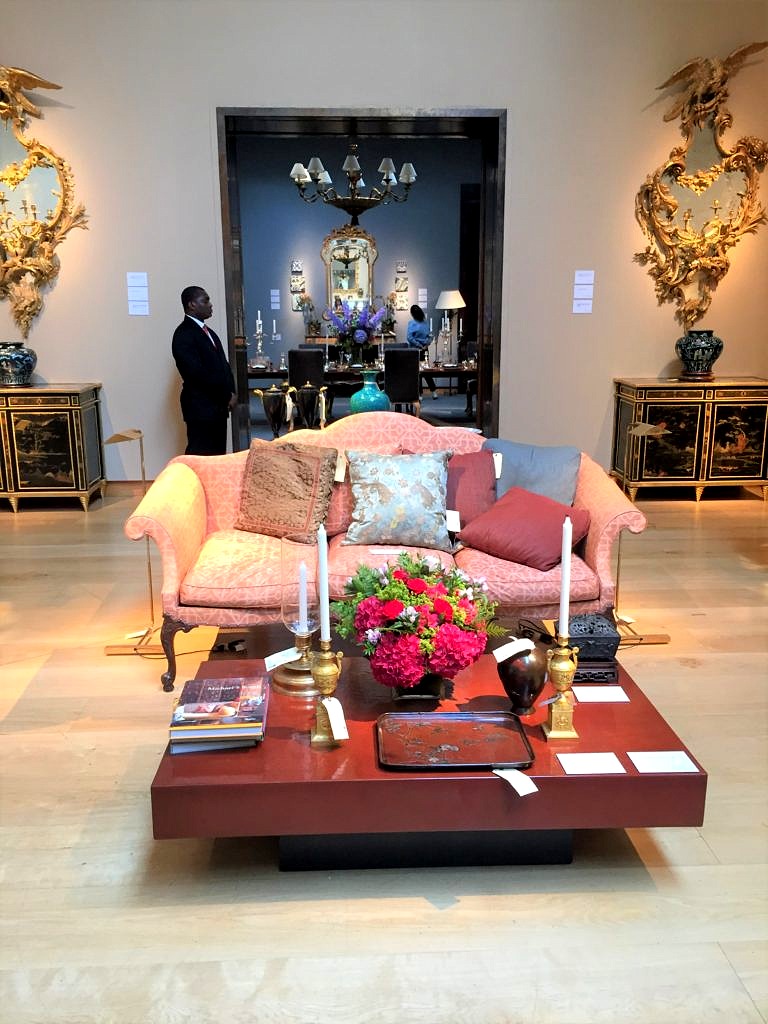
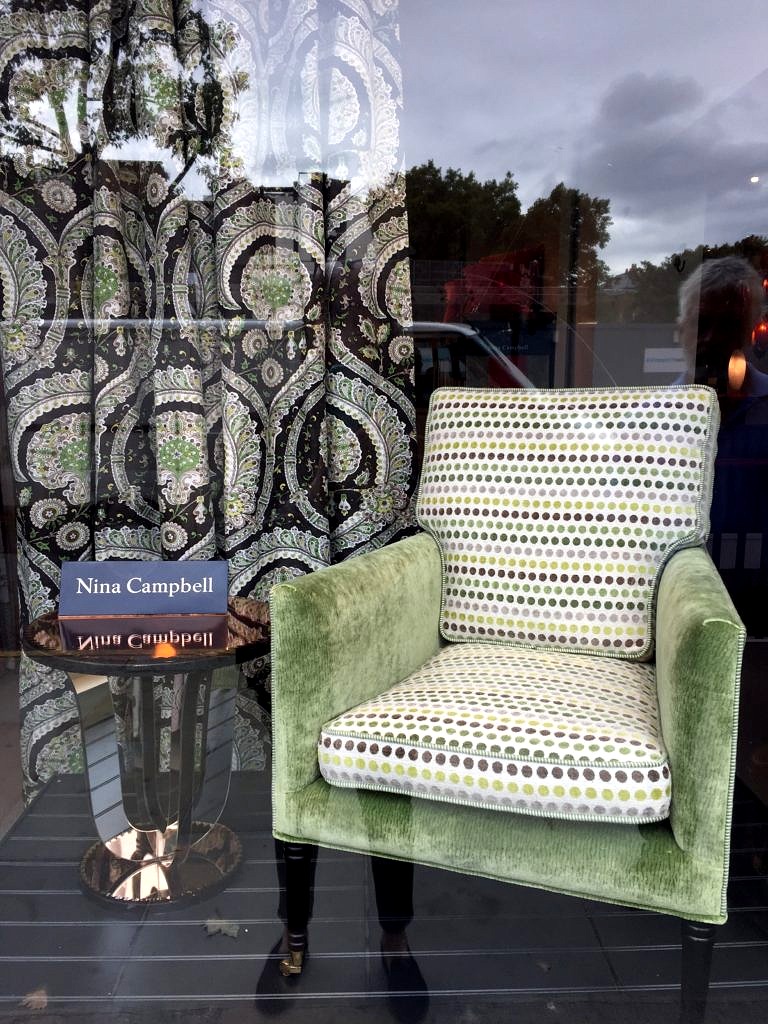 The latest from
The latest from 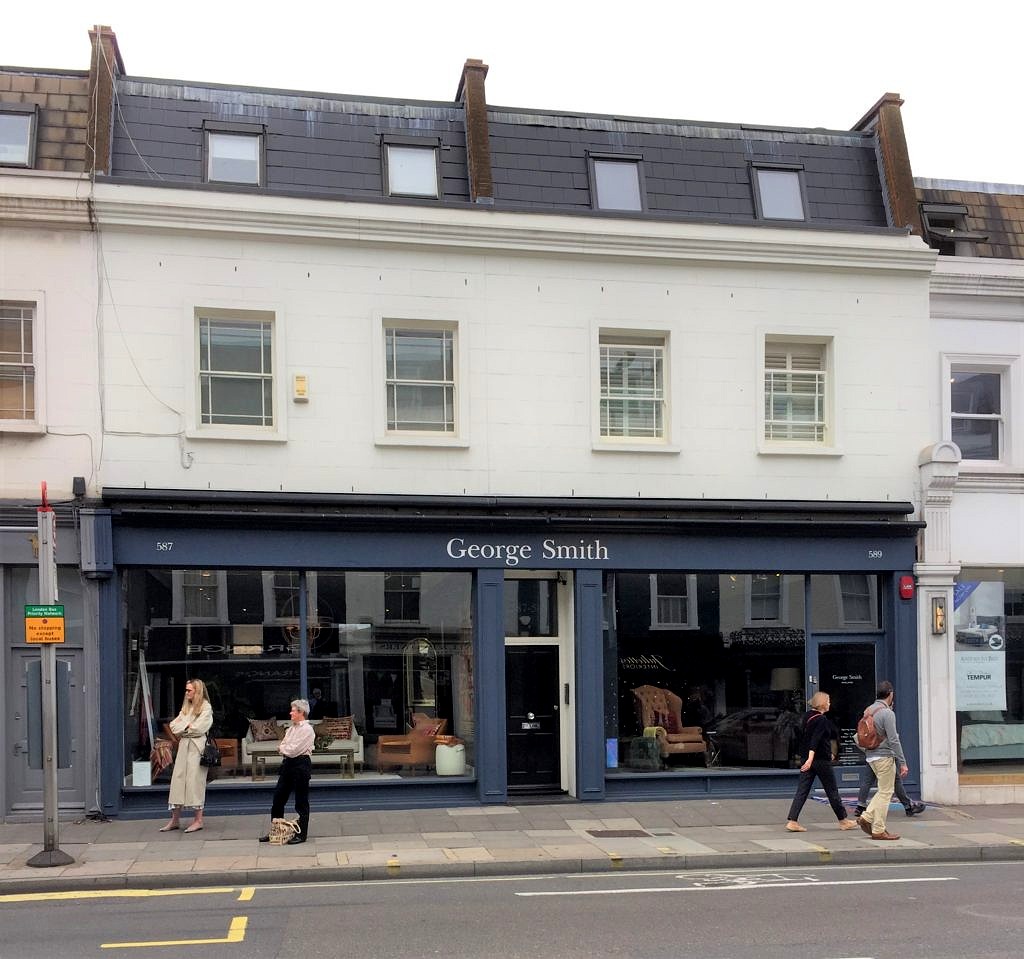
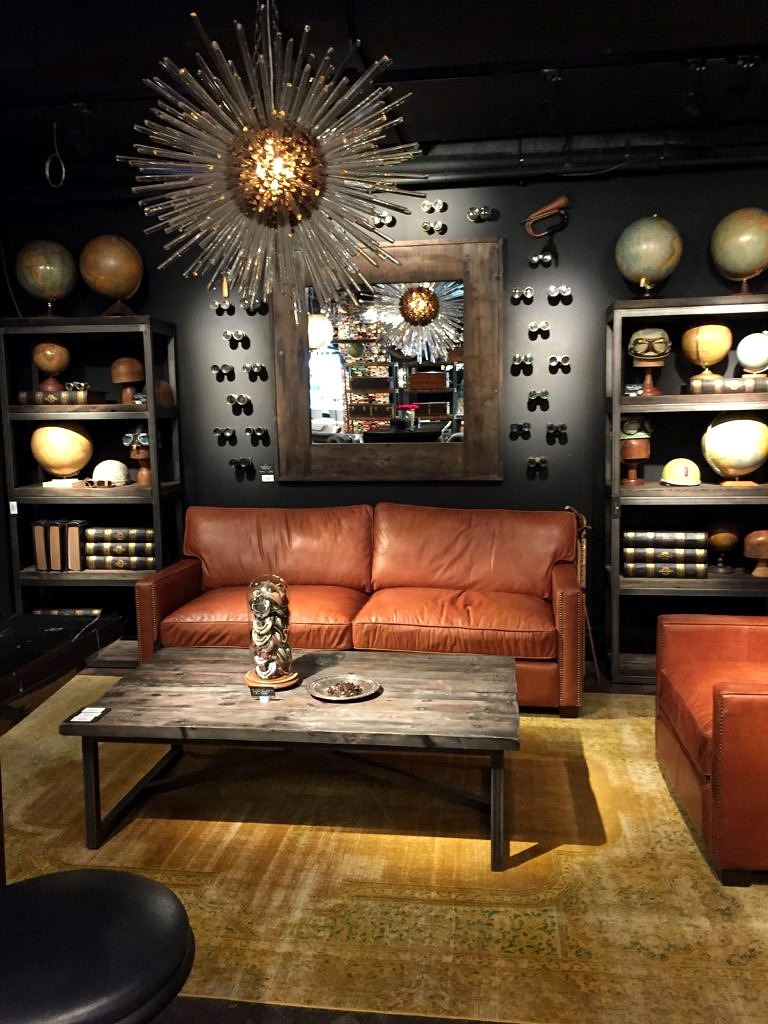 Then we spent a long time at Trowbridge Galleries, the leading purveyors of art photography in England, and a vendor we are considering for the store.
Then we spent a long time at Trowbridge Galleries, the leading purveyors of art photography in England, and a vendor we are considering for the store. Next stop was the London
Next stop was the London 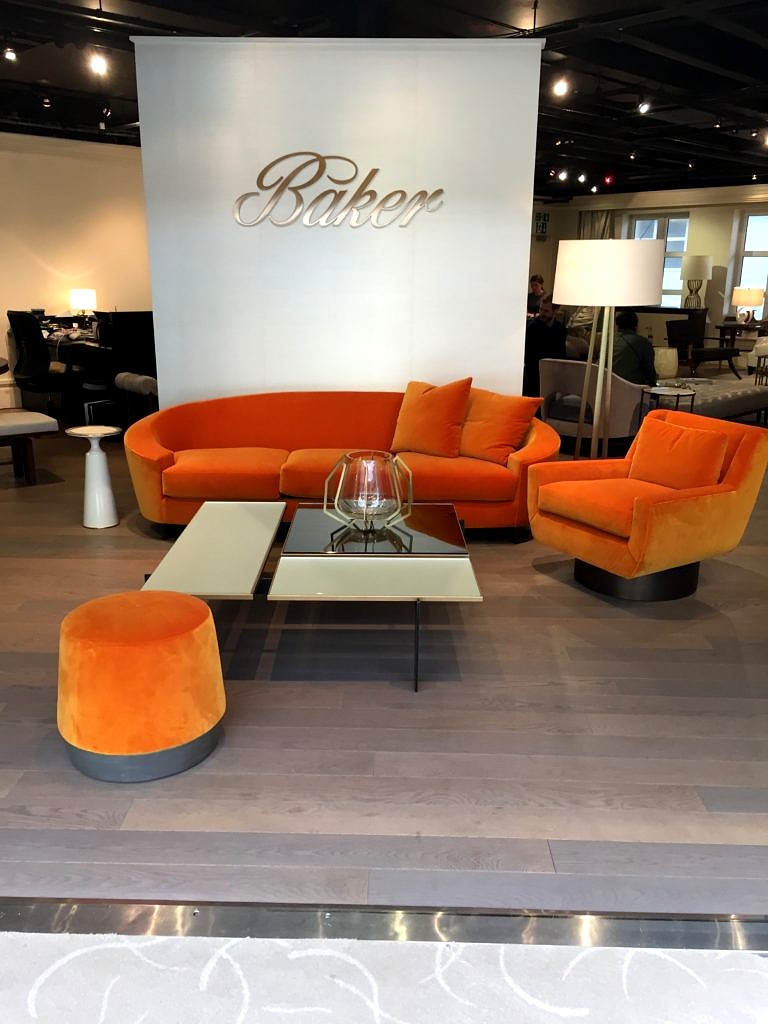 They were madly putting the finishing touches on many of the showrooms in preparation for the London Design Week. Loved the color of these sofas; clearly you can’t go wrong with pumpkin this fall.
They were madly putting the finishing touches on many of the showrooms in preparation for the London Design Week. Loved the color of these sofas; clearly you can’t go wrong with pumpkin this fall. 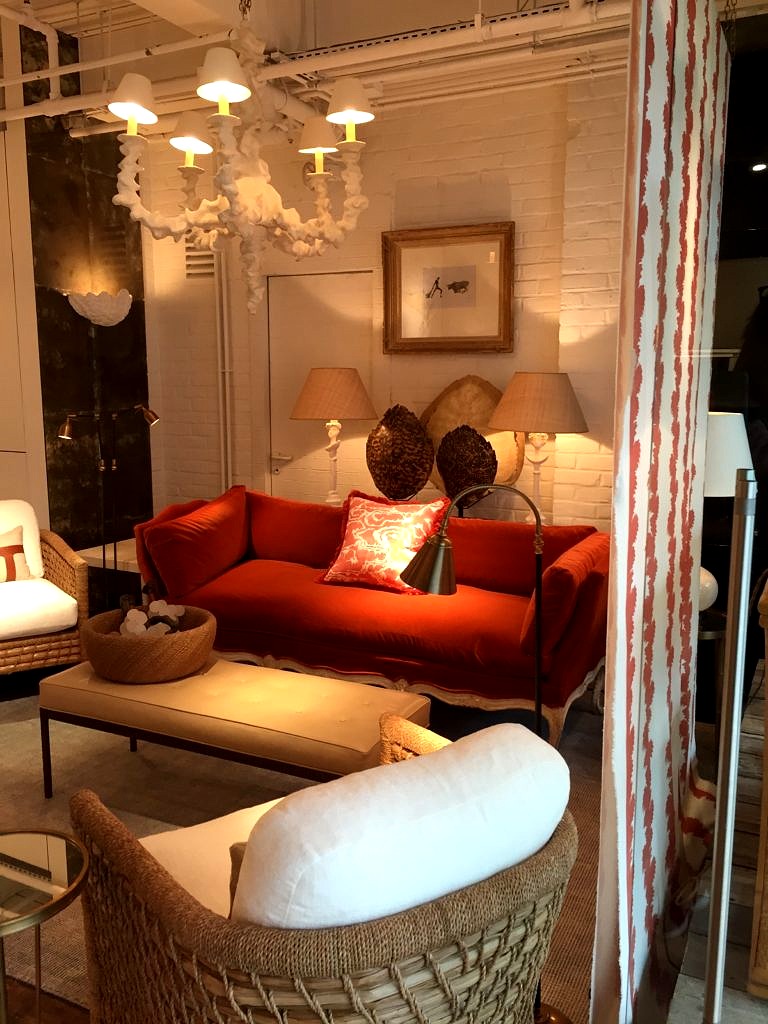 It was a great way to wind up our trip and a fabulous opportunity to see the latest in home decor from a whole slew of world-class designers and renowned retailers. But eventually all good things must end; it was time for us to go home.
It was a great way to wind up our trip and a fabulous opportunity to see the latest in home decor from a whole slew of world-class designers and renowned retailers. But eventually all good things must end; it was time for us to go home.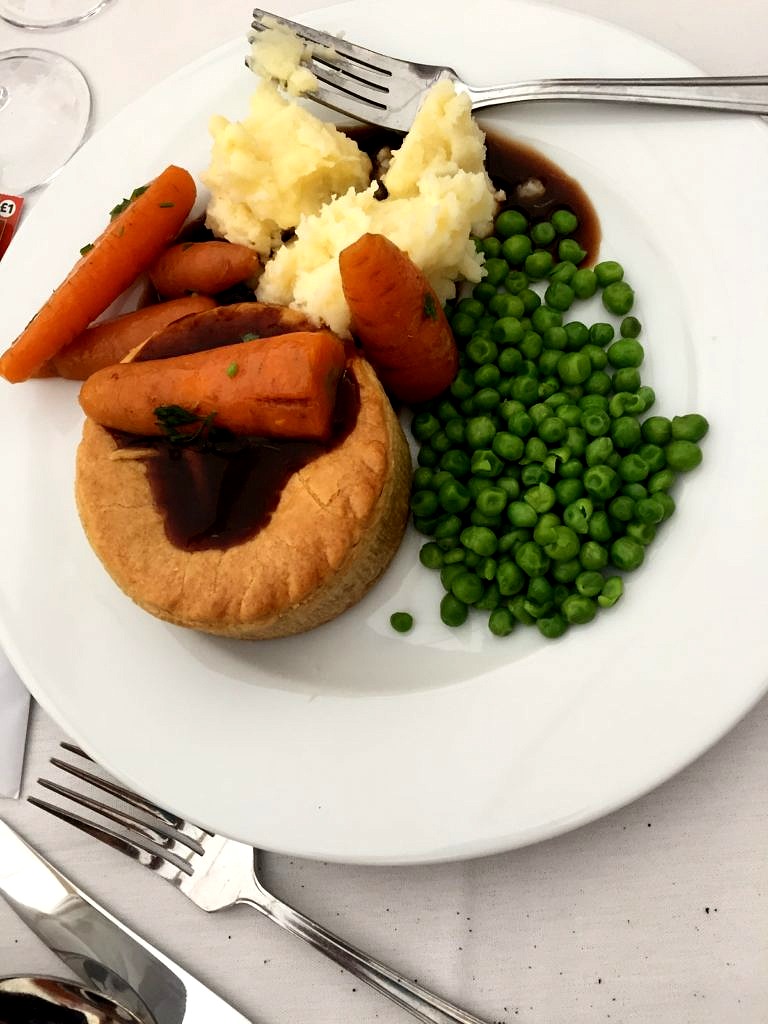 So I googled meat pies until I figured out how to do it. Here’s the Nelson Family version.
So I googled meat pies until I figured out how to do it. Here’s the Nelson Family version.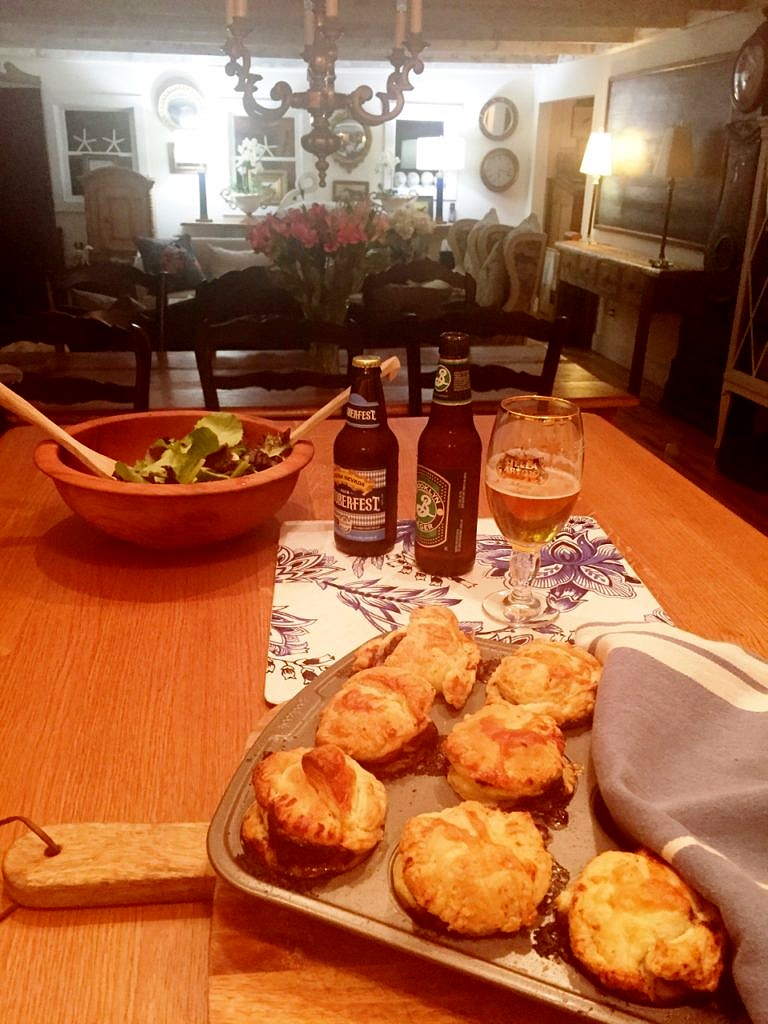 Not bad for a first try–easy as pie! Keith was happy to have a taste of home and now you can too.
Not bad for a first try–easy as pie! Keith was happy to have a taste of home and now you can too.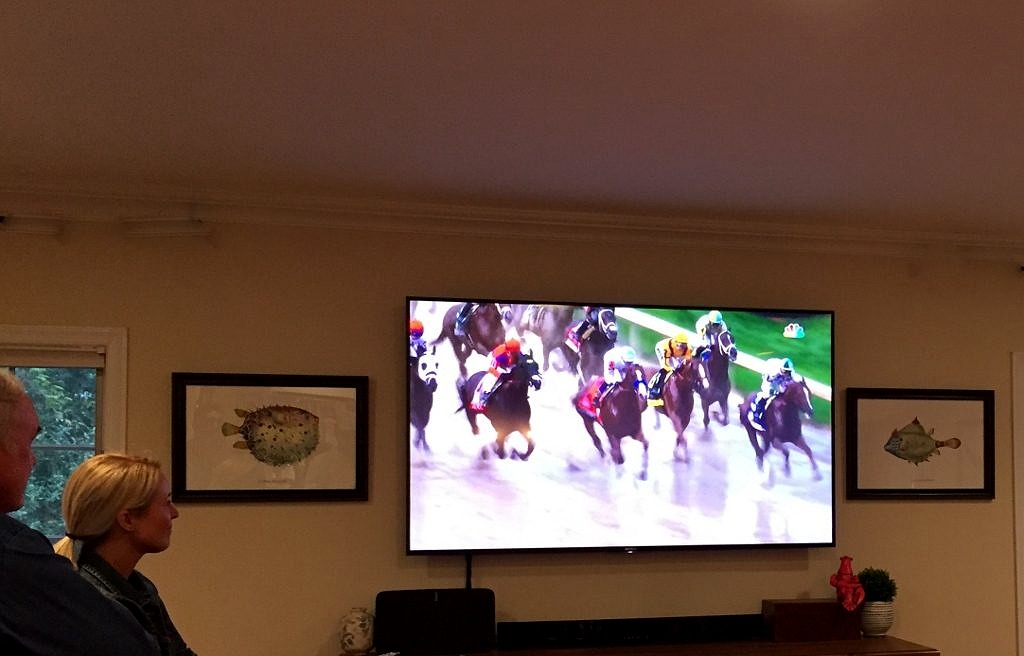 Given the rotten weather we’ve been having these days the only way I was sure spring was here was when I was drinking mint juleps and watching the Kentucky Derby. We were happy to be invited to a small gathering of friends, parents, children–and dogs at the Lindekin home in Shrewsbury–second generation British Cottage shoppers by the way. Which is good because it confirms that the love of decorating is genetic and sad because we are clearly getting up there.
Given the rotten weather we’ve been having these days the only way I was sure spring was here was when I was drinking mint juleps and watching the Kentucky Derby. We were happy to be invited to a small gathering of friends, parents, children–and dogs at the Lindekin home in Shrewsbury–second generation British Cottage shoppers by the way. Which is good because it confirms that the love of decorating is genetic and sad because we are clearly getting up there.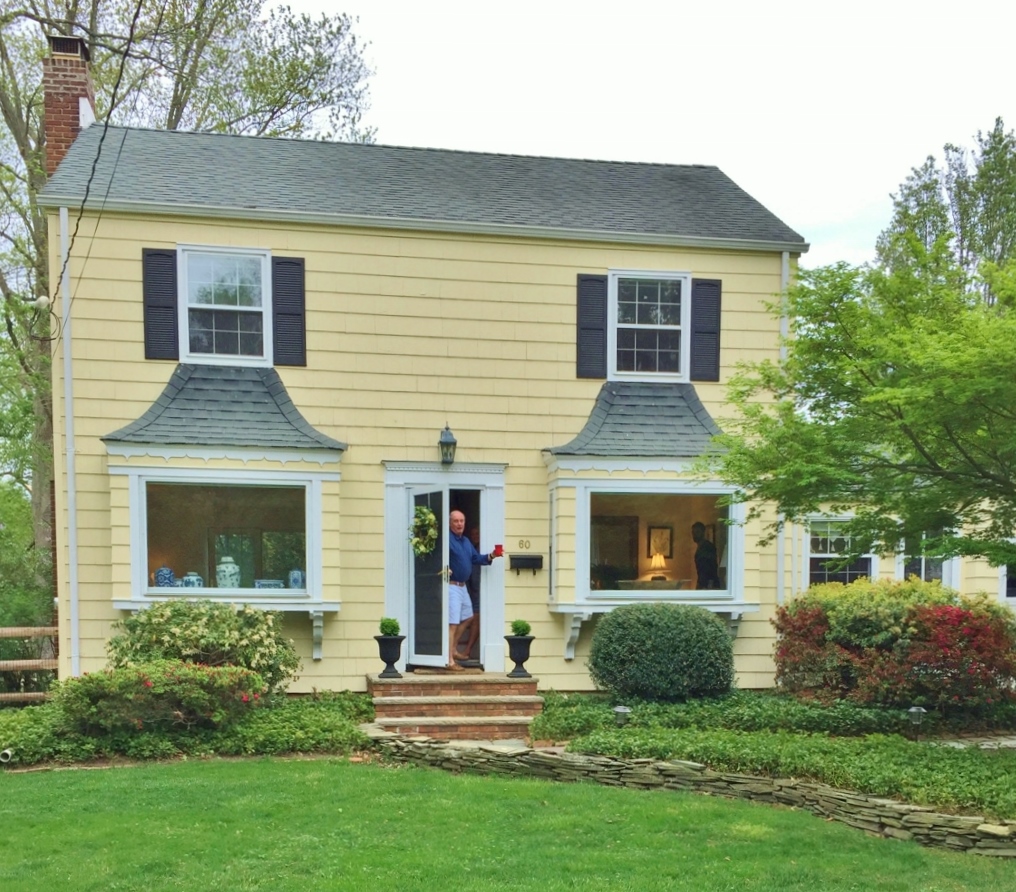 Their house is painted a cheerful yellow with two bay windows flanking the front door; it may technically be a starter home, but I could easily see finishing up here. The yard is huge and the house is bigger than it looks because the previous owners were very careful not to let the large extension they put on in the back impact on the charm of the original structure.
Their house is painted a cheerful yellow with two bay windows flanking the front door; it may technically be a starter home, but I could easily see finishing up here. The yard is huge and the house is bigger than it looks because the previous owners were very careful not to let the large extension they put on in the back impact on the charm of the original structure.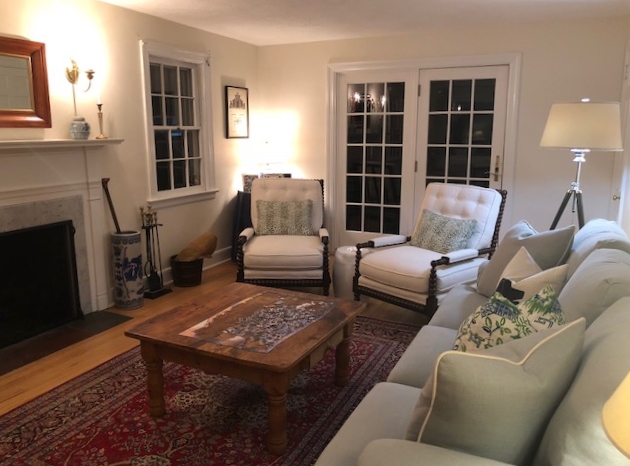 And on the right is what was the dining room but now is a kind of an enlarged foyer. There was a huge debate about what to put in this room–clearly they nailed it!
And on the right is what was the dining room but now is a kind of an enlarged foyer. There was a huge debate about what to put in this room–clearly they nailed it!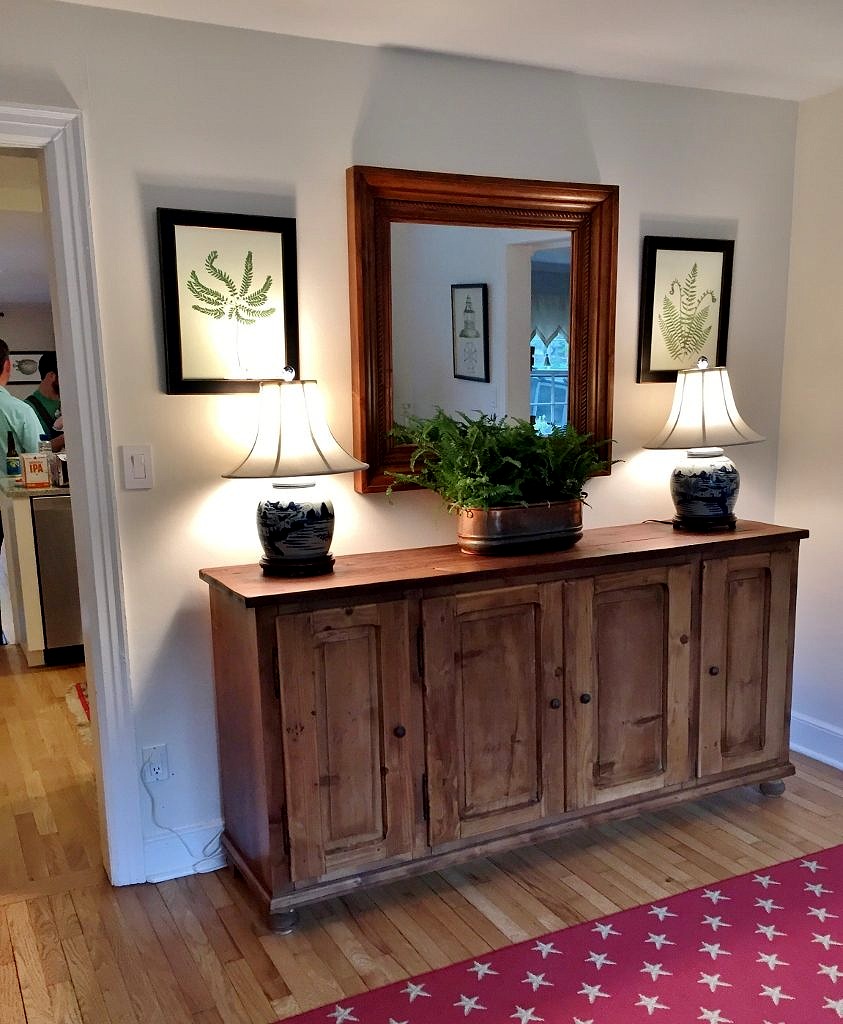 Now all the dining takes place in the extension, which also houses the flatscreen televison, and man cave elements like the huge leather couch –and the bar. The cabinet anchoring the TV is a British Cottage find, as are the vintage French fish prints.
Now all the dining takes place in the extension, which also houses the flatscreen televison, and man cave elements like the huge leather couch –and the bar. The cabinet anchoring the TV is a British Cottage find, as are the vintage French fish prints.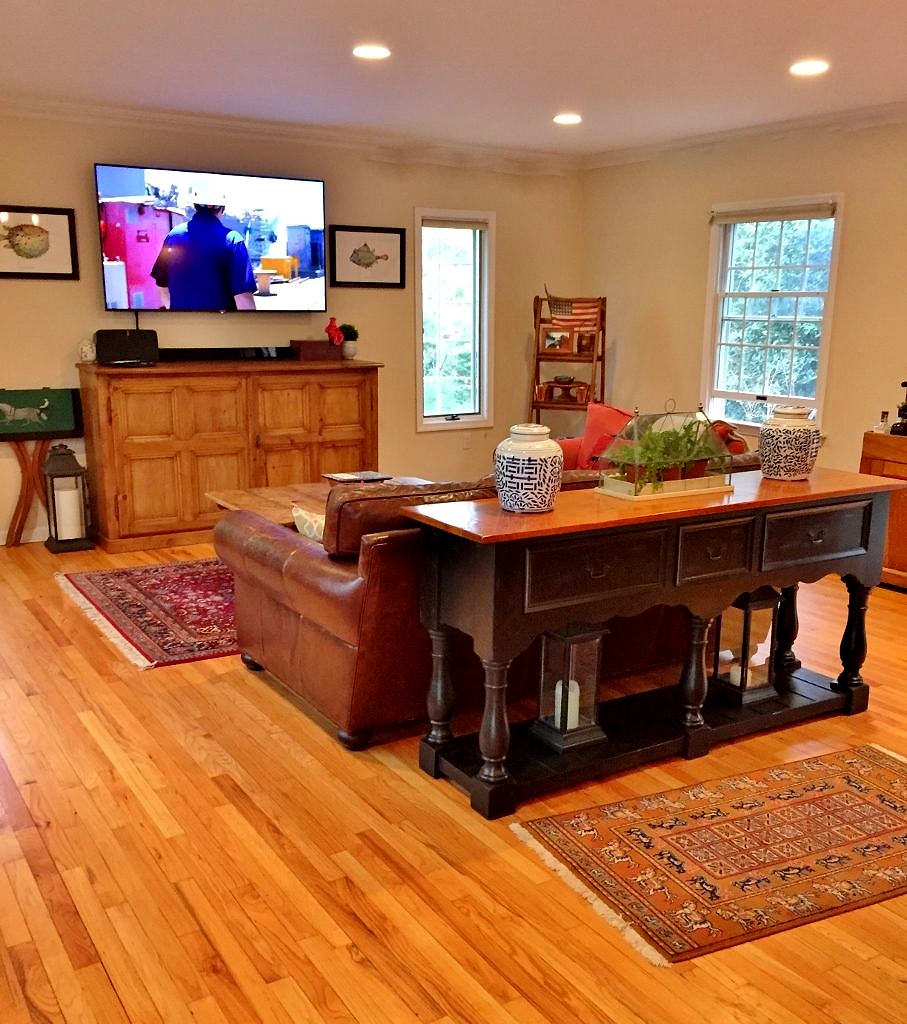
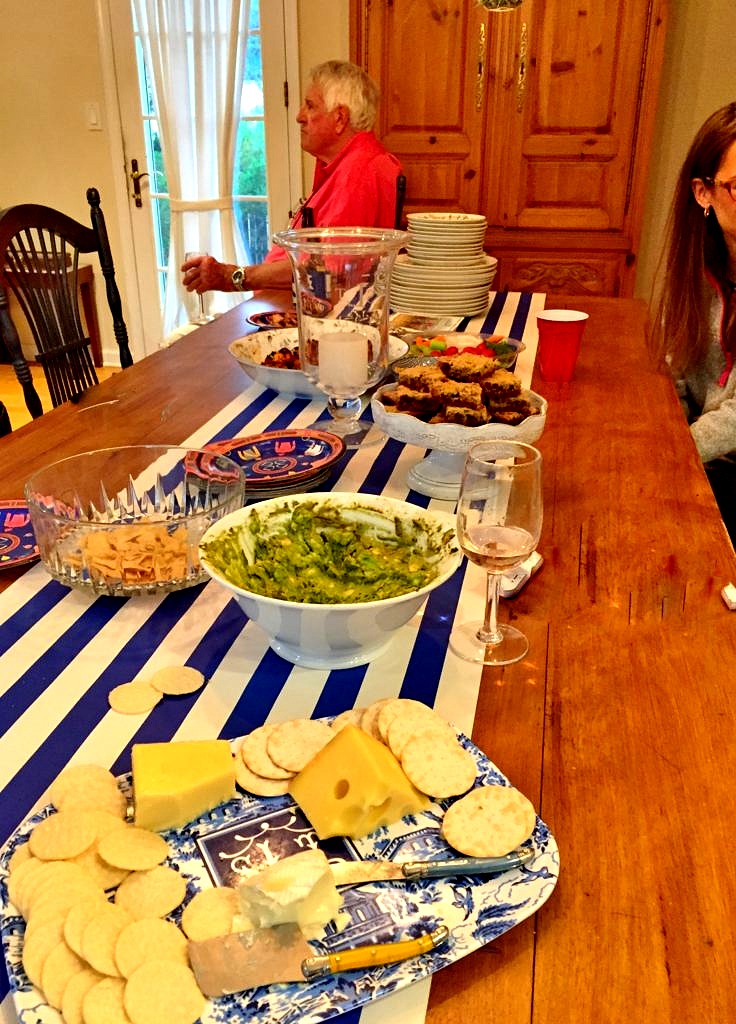 Then there is a huge farm table (from British Cottage) that this evening was all set up for a glorious buffet supper.
Then there is a huge farm table (from British Cottage) that this evening was all set up for a glorious buffet supper.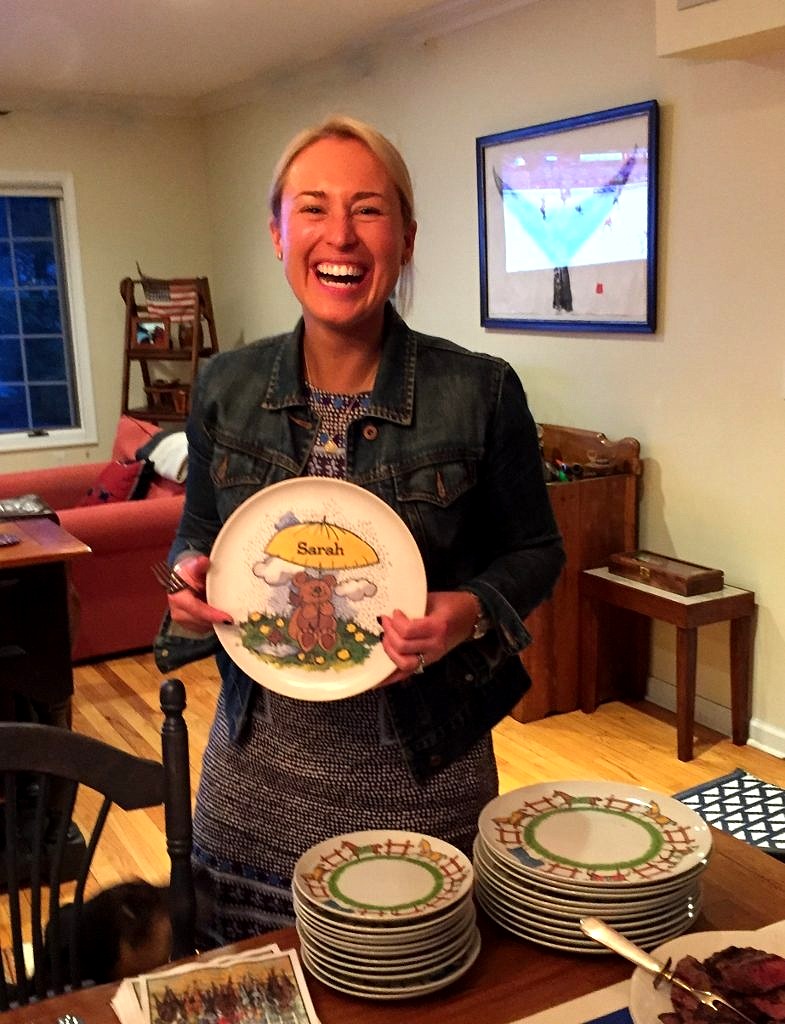 Which all the guests, and hosts, enjoyed immensely.
Which all the guests, and hosts, enjoyed immensely.
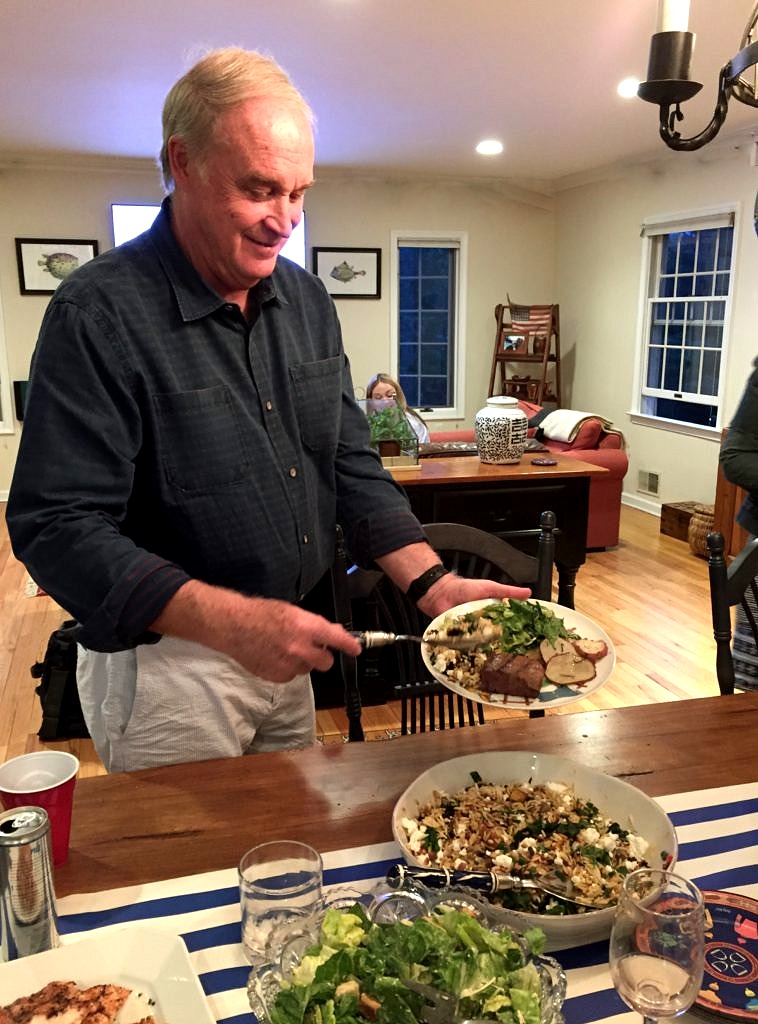

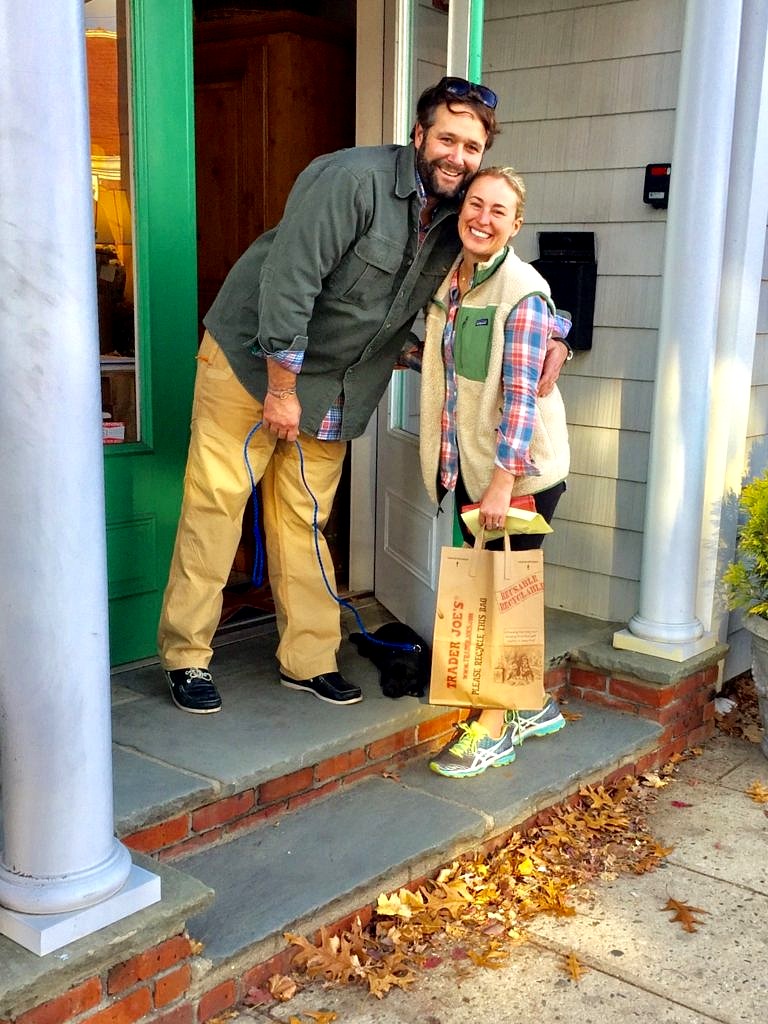
 Built by German immigrants in 1840, Tip Top Farm in Colts Neck started out as a relatively modest asparagus farm, but by the mid-1900s it had become the country manse of the Chairman and chief stock holder of the National Starch Company. Now it is home to a thoroughly modern 21st century family.
Built by German immigrants in 1840, Tip Top Farm in Colts Neck started out as a relatively modest asparagus farm, but by the mid-1900s it had become the country manse of the Chairman and chief stock holder of the National Starch Company. Now it is home to a thoroughly modern 21st century family.

 Next up is what was originally the library and now I would call it the family room. I was happy to be reunited with the oversized clock face we bought ten years ago for our Potting Shed from heaven in the second Stately Homes by the Sea Showhouse. Not many people would have thought to put it here, but you have to admit it does pack a punch. The pine bench to the left is nearly 10 feet long and neatly fills the space–as it did in our upstairs hallway until the homeowner spied it!
Next up is what was originally the library and now I would call it the family room. I was happy to be reunited with the oversized clock face we bought ten years ago for our Potting Shed from heaven in the second Stately Homes by the Sea Showhouse. Not many people would have thought to put it here, but you have to admit it does pack a punch. The pine bench to the left is nearly 10 feet long and neatly fills the space–as it did in our upstairs hallway until the homeowner spied it! Next up is the dining room.
Next up is the dining room.
 That is one of our fabulous flip top tables in the window. Closed it is the perfect console table but open it can sit eight. Everybody wants a more informal style dining table these days–but with a leaf–and mostly they don’t exist. So the two or three times a year you need more dining space this extra table cracks it. Note that tucked under the console table is a bench for–you guessed it–extra seating.
That is one of our fabulous flip top tables in the window. Closed it is the perfect console table but open it can sit eight. Everybody wants a more informal style dining table these days–but with a leaf–and mostly they don’t exist. So the two or three times a year you need more dining space this extra table cracks it. Note that tucked under the console table is a bench for–you guessed it–extra seating. The red sideboard is another British Cottage find. Really distressed and on the industrial side so I admit I to being a bit perplexed when this went on the truck, but as you can see it is perfect for the spot.
The red sideboard is another British Cottage find. Really distressed and on the industrial side so I admit I to being a bit perplexed when this went on the truck, but as you can see it is perfect for the spot.
 Another case in point is this most fabulous breakfront we found at
Another case in point is this most fabulous breakfront we found at  Finally I made it to the kitchen and the first piece of British Cottage furniture purchased for this home-the pine corner cupboard. Although the kitchen was totally renovated a few years ago, the cabinet stayed. I love everything about this room: the porcelain tile “wood” floor, the gorgeous tin ceiling, and the swivel chairs in a bold fabric.
Finally I made it to the kitchen and the first piece of British Cottage furniture purchased for this home-the pine corner cupboard. Although the kitchen was totally renovated a few years ago, the cabinet stayed. I love everything about this room: the porcelain tile “wood” floor, the gorgeous tin ceiling, and the swivel chairs in a bold fabric. On the other side of the kitchen there is a breakfast room with a barn door concealing the pantry on one side. And custom cabinets on the other.
On the other side of the kitchen there is a breakfast room with a barn door concealing the pantry on one side. And custom cabinets on the other. Instead of built ins for this breakfast nook/butlers pantry the owners had us make two cabinets to flank a painted pine chest with drawers. Note another decorating secret in action–you can be fearless with green because all greens go together. If you don’t believe me think of a forest.
Instead of built ins for this breakfast nook/butlers pantry the owners had us make two cabinets to flank a painted pine chest with drawers. Note another decorating secret in action–you can be fearless with green because all greens go together. If you don’t believe me think of a forest.

 The original recipe from the owner’s grandmother, in her handwriting. Short and sweet and totally delicious.
The original recipe from the owner’s grandmother, in her handwriting. Short and sweet and totally delicious.
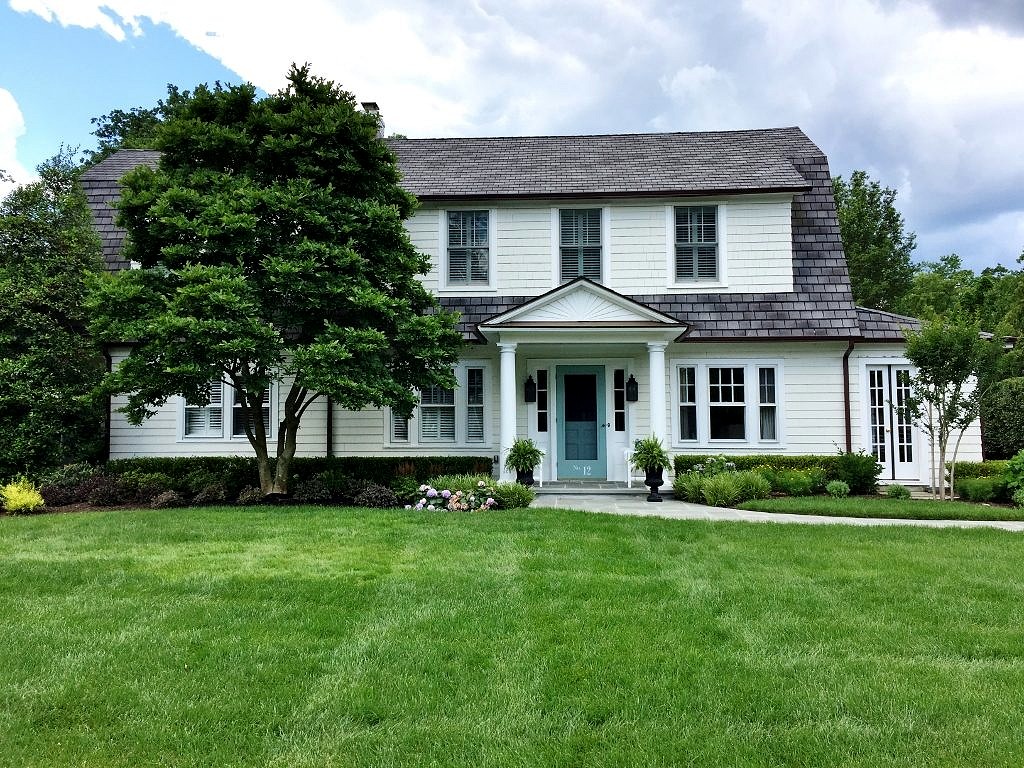 There are so many things to love about this house but my favorite might be the Dutch door. I have wanted a Dutch door my entire life and Bernadette’s is absolutely the most perfect shade of blue.
There are so many things to love about this house but my favorite might be the Dutch door. I have wanted a Dutch door my entire life and Bernadette’s is absolutely the most perfect shade of blue.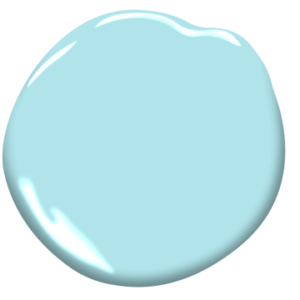 It turns out to be
It turns out to be 